Greece › Santorini › Wineries & Wine Tours
Updated: June 6, 2025
By Santorini Dave
• Santorini hotels
• Santorini towns
• Santorini beaches
• Santorini restaurants
• Santorini things to do
• Santorini boat tours
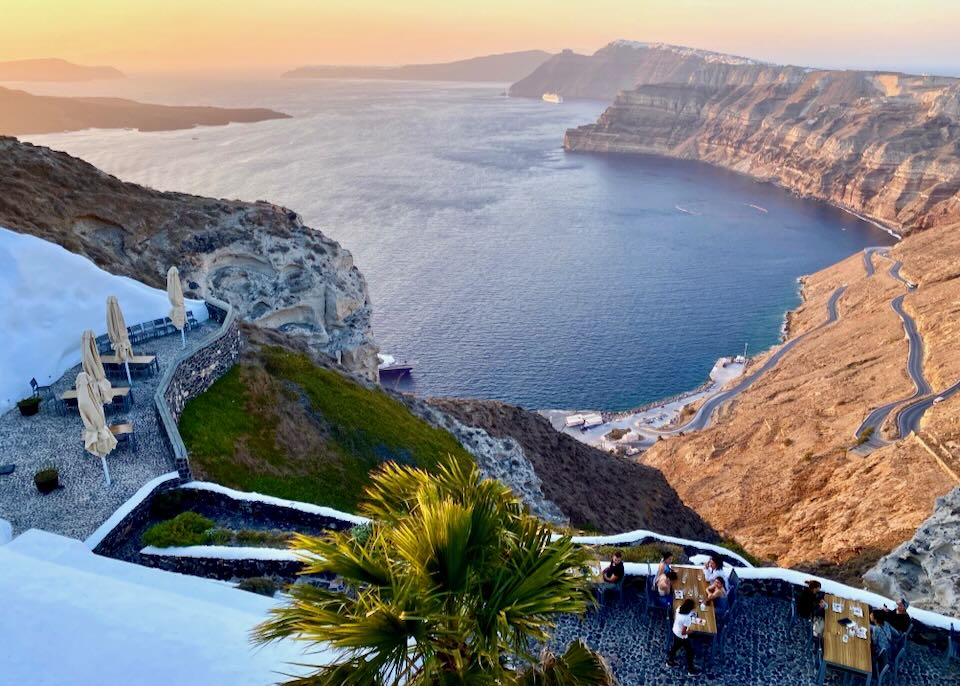
The view of the Santorini caldera from Venetsanos winery on the Sunset Wine Tasting Tour.
Santorini entices over two million tourists annually to marvel at its astonishing geography, with sheer rocky cliffs soaring high above its gorgeous blue-purple caldera in the Aegean Sea. The caldera is the result of a massive volcanic eruption in 1600 BC that covered the island in volcanic debris; to this day, Santorini’s soil is made up of volcanic ash, sand, and pumice stone.
The combination of the island’s volcanic soil, intense sun, and extreme wind produces very distinctive grape varieties. Grapevines on Santorini are also uniquely cultivated in accordance with an age-old pruning system, which protects the grapes and helps them to flourish amid the island’s severe conditions. Santorini is home to some of the oldest vineyards in the world, containing ancient indigenous vines.
Wine tasting at Sigalas Winery near Oia.
Over the last decade, Santorini’s wines have gained worldwide recognition, and their superior quality is now undeniable. Santorini is ranked Greece’s #1 wine destination and is sometimes called “the wine island,” boasting twenty wineries and counting.
Santorini Wine Tours – My Advice
Highly recommended: A Santorini wine tour that visits multiple wineries. Pictured: Gavalas Winery.
- Many Santorini wineries offer tours and tastings, but if you want to visit multiple wineries, book a wine tour. While it’s possible to visit wineries on your own, a tour makes getting from one to the next much quicker and easier. (Most wineries are small and hard to find if you don’t know the island well, and most tours include hotel pick up and drop off.) Plus, drinking and driving is very uncool.
- Wine tours are incredibly popular on Santorini and they fill up quickly – so book early. Santorini boat tours don’t sell out as early as wine tours do, so book your wine tour first. Most wine tours run from March to November.
- Best Santorini Winery Tours: Santorini Small Group Wine Tour • Santorini Private Wine Tour
- Best Wine Tours with Sunset: Santorini Wine Tasting • Santorini Sunset Wine Tour
- The Santorini wineries with the best caldera views are Santo and Venetsanos. Most wine tours will visit one or both of them.
- Greek Cooking Classes: There are excellent cooking classes held in Oia, Fira, and the fantastic Artemis Karamolegos Winery.
See Also
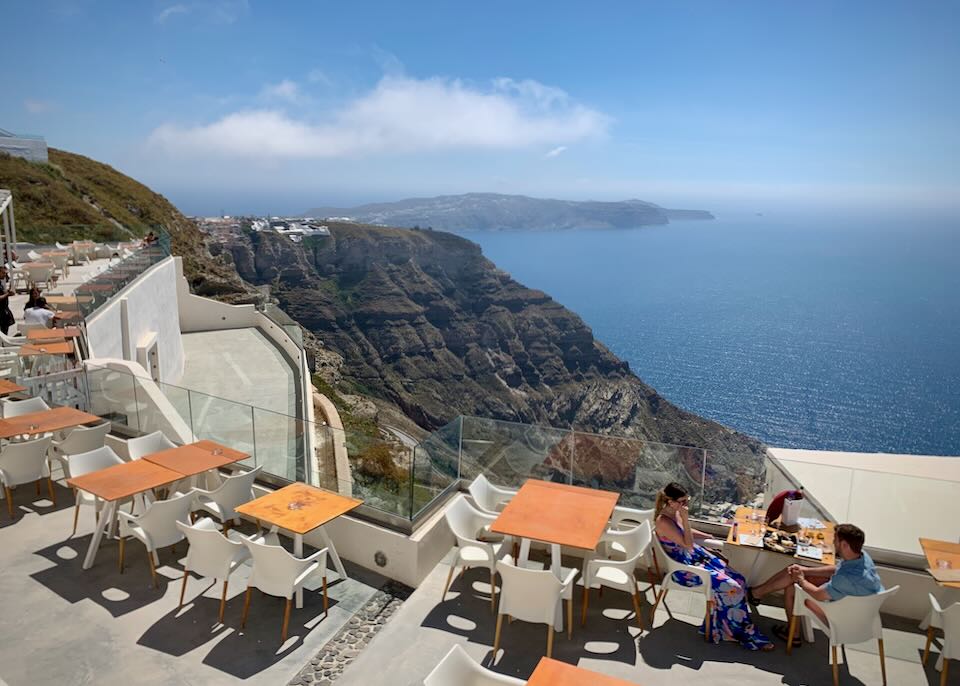
Most Santorini wine tours visit one of the two wineries with sweeping Caldera views – Santo and Venetsanos. This is Santo Wines outside of Pyrgos.
The Best Wine Tours in Santorini
1. Small Group Santorini Wine Tour
A great small-group tour that visits three traditional wineries and vineyards scattered around Santorini. Hotel pick up and drop off makes it all super easy. Will usually visit Santo Winery or Venetsanos (both with great caldera views – Santo is pictured above) or Gavalas (my favorite) and 2 others. Starts at 3:30pm and lasts a little over four hours.2. Santorini Private Wine Tour
This is a private wine tour for serious wine lovers. The intimacy and attention to detail are definitely worth the splurge, but maybe not for everyone. Most people do the tour as a couple, but it can accommodate a group of up to 6. Starts at 10am or 4pm, with the evening tour enjoying a sunset view from either Santo or Venetsanos Winery.3. Santorini Sunset Wine Tasting
A wonderful small group tour in the early evening; visit 3 wineries and have 12 tastings. Starts at 4pm and usually finishes at Venetsanos Winery (pictured above) for fantastic caldera views at sunset.Fully Booked Wine Tours
It’s common for the above tours to sell out in June, July, August, and September. If so, these tours are also excellent:
• Half-Day Wine Adventure Tour
• Santorini Sunset Wine Tour
The Best Santorini Wineries
Most of the island’s wineries are located in the center of the island, south of Fira, between the ferry port and the airport. Of the twenty wineries on the island, fifteen are open to the public for tours and wine tasting.
1. Gavalas Winery – Megalochori
My favorite winery on Santorini. Small, friendly, intimate, and family-run for five generations. Their flagship wine is their Santorini Assyrtiko in its famous blue bottle – a high-quality classic. This wine is one of the few white wines that contains tannins.Gavalas has also made efforts to focus on several rare grape varieties, such as Katsano and Gaidouria. Their Gavalas Katsano is produced in small amounts and is a blend of these two grapes exhibiting floral and herbal aromas combined with honey and lime flavors.
There is no restaurant onsite, but there is a good taverna nearby. Gavalas can be somewhat hard to find if you’re driving on your own.
2. Venetsanos Winery – Megalochori
One of the most well-known and oldest wineries on the island, with spectacular views of the caldera, volcanic cliffs, and Santorini’s famous sunset. This winery was built in 1947, closed in 1974, and reopened in 2014 after renovating and modernizing its wine-making equipment. Venetsanos has recently introduced an Assyrtiko-Aidani Orange wine with apricot, peach, grapefruit, apple, and pear aromas.Its cliffside location means that it is somewhat exposed to the winds, and the outdoor terrace may be closed if it’s an especially windy day. Of the two caldera view wineries, Venetsanos offers similar views as Santo but is a bit smaller, with a little more charm.
3. Domaine Sigalas – Oia
A small, scenic winery in Baxedes near Oia, a 10-minute walk from a bus stop on the Fira-Oia bus route. Sigalas offers award-winning wines and good views of the sunset year-round.The founder, Paris Sigalas, has operated the winery since the early 1990s. Their 40 hectacres of vineyards produce 200,000 bottles a year. They are open for small tours, wine tastings, and the option to pair any of their wines with excellent food. Tastings are held both in their tasting room indoors and outside on their beautiful patio overlooking their vineyards.
4. Santo Wines – Pyrgos
Large and modern winery with amazing caldera views. They are the largest wine producer in the Cyclades island group, and one of the most well-known wineries on the island, producing 50% of Santorini’s total wine production. They maintain a privately owned organic vineyard and feature four organic wines: 100% Assyrtiko, 100% Athiri, 100% Aidani, and 100% Mavrotragano. They also produce Santorini’s only sparkling white Assyrtiko wine.Santo has an onsite wine tourism center open all year round, and offers the most comprehensive tours of any one winery. Their sun-drenched restaurant and patio are ideal spots to watch the sunset. It can be a busy place in the peak summer season, but their seating area is expansive and there is a huge onsite parking lot. (Santo is a popular stop on many wine tours.)
Santo Wines is a cooperative that was founded in 1947. In addition to their wide selection of wines, they also maintain a large shop selling Santorini tomatoes, fava, capers, caper leaves, and sweet preserves.
5. Art Space Winery – Exo Gonia
This small and unique winery is a spellbinding blend of modern winery, art gallery, and museum within a centuries-old wine cave. The owner guides you around the property and explains its history with a thick Greek accent. Very cool.Art Space’s main varieties are: Assyrtiko, Aidani, and Mavrotragano. Although Art Space is not certified organic, organic grapes are used to make their wines.
Santorini Winery Overview
We discuss Santorini wine and wineries with Master of Wine Yiannis Karakasis in Athens. (He literally wrote the book on the topic.)
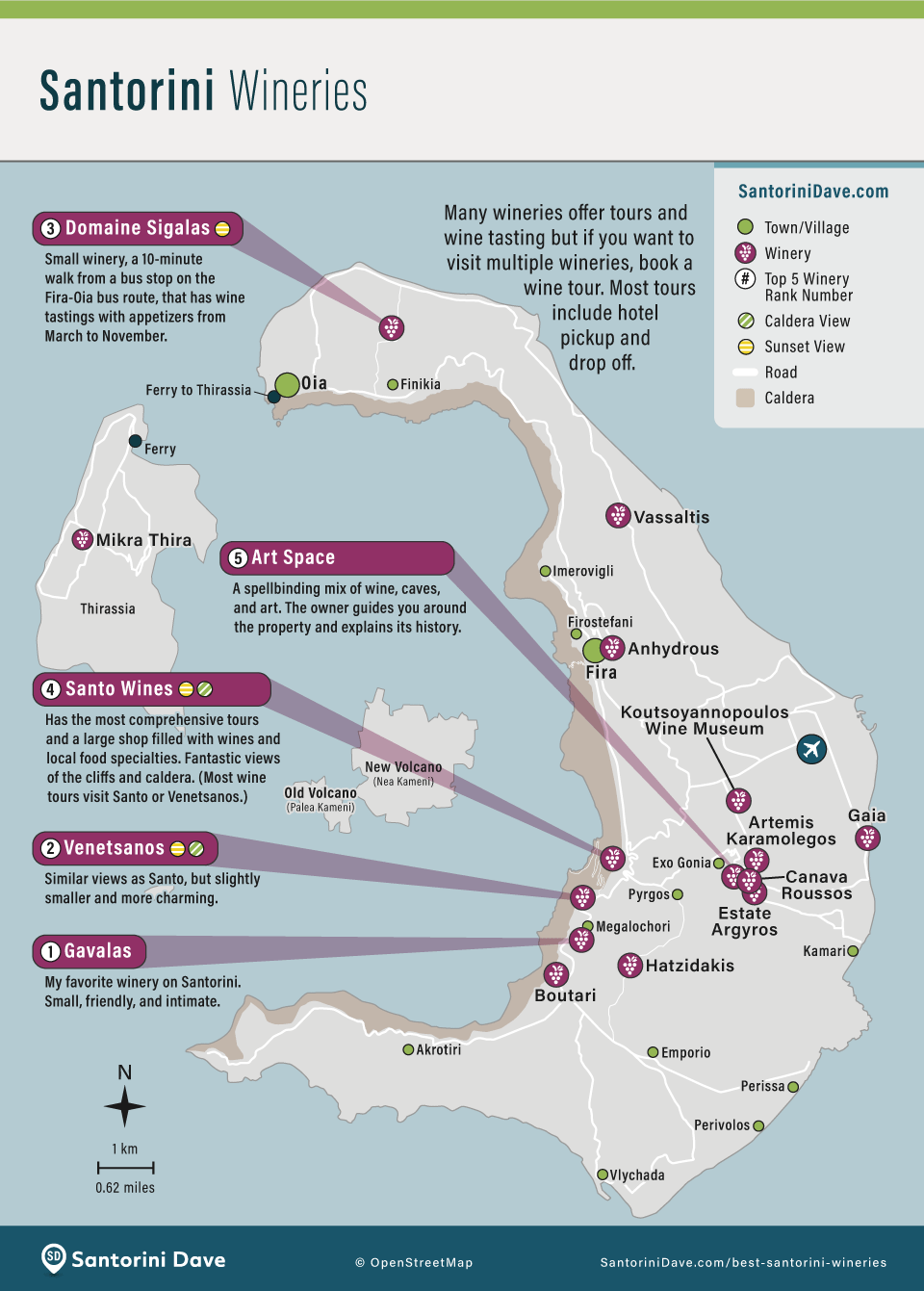
More Great Santorini Wineries
Anhydrous – Fira
This winery’s restaurant and tasting room are located a short 10-minute walk from the main square in Fira. Anhydrous Winery derives its name from “Anydros,” which means waterless in ancient Greek, as the vineyards are hydrated only by the island’s sea mist. Cement egg-shaped tanks are used to age their Anhydrous Icon wine (one of their five varieties of wine). These cement tanks help to keep the temperature more evenly regulated.Their Anhydrous Restaurant is beautiful and features an open-air patio with lots of shade. Cooking lessons are also available. An onsite spa offers both face and body treatments using their exclusive cosmetics made from grapes. Their cosmetics are available for purchase at the winery.
Argyros Estate – Episkopi Gonia
Beautiful and modern winery that is the largest single-owner vineyard on the island. Voted in the top 50 of the world’s best vineyards and wine destinations.Argyros is considered to have one of Santorini’s best Vinsanto wines (sweet wine); their Monsignori vineyard has two hundred-year-old vines from when their ancestors made Vinsanto for the church. The winery does follow some organic practices, and their use of herbicides is low, though they are not a certified organic grower.
Artemis Karamolegos – Exo Gonia
A charming modern winery that’s been a family-run operation for three generations. Their vines grow in six villages on Santorini, providing a wide selection of the best terroirs on the island.Their red grape Mavrotragano is one of their newest plantings and is wire-trained (not the traditional kouloura basket-trained vines) to allow more sunlight to reach the branches. Prior to their cultivation, Mavrotragano was near extinction on Santorini. Their restaurant, Aroma Avlis, features fresh seafood and vegetarian options, and they offer an amazing Greek cooking class right on site.
Boutari – Megalochori
A beautiful dome winery that was built in 1989. Boutari is one of the most awarded and historical wine producers in Greece. The winery is small, focusing on Assyrtiko, Athiri, and Aidani grapes.Their onsite indoor restaurant serves traditional local food such as fava, tomato fritters, and traditional pork sausage. Boutari Winery is not open on Sundays.
Canava Chrissou & Tselepos – Pyrgos
The newest winery on Santorini; at the time of this writing, the winery is not open to the public for tours or tastings. This winery produces three white varieties, and eighty percent of its total production is exported to the USA, Canada, and China.
Canava Roussos – Episkopi Gonia
Traditional and charming, this is the island’s oldest winery, having been founded in 1836. It has been a family-run operation for over six generations. Aged Nykteri wine and Vinsanto wine are their specialty. Their outdoor theater hosts musical performances and concerts.Gaia – Perivolia
Gaia Winery is beachside on Santorini’s east coast, with a rustic wine-tasting patio directly on the water.Their wine collection features an exceptional offering and a novel approach to wine aging. Their Assyrtiko variety wine named Gaia Thalassitis Submerged is bottled and then aged underwater in an environment that is entirely free of oxygen and light. Every year, roughly 500 bottles are put in a crate and then submerged 20 meters underwater off the east coast of Santorini for four years. The results have been very successful. The wine is vibrant, takes on a smoky aroma, and has a rounder quality. Additionally, the wine bottle is very distinctive – complete with barnacles attached. Not surprisingly, Gaia Thalassitis Submerged is their most expensive wine.
Gaia Wines’ total yearly production is 120,000 bottles. Their wine Gaia Thalassitis (the non-submerged variety) is a classic expression of Santorini Assyrtiko. The winery has no restaurant, but meat and cheese platters are available.
Hatzidakis – Pyrgos
The only certified organic wine producer on the island of Santorini, the winery is located down a narrow and windy road, overlooking its expansive vineyard near the village of Pyrgos.Hatzidakis Winery’s philosophy from vine to wine is simplicity with limited intervention. The new winery mimics a traditional canava (an underground cave winery); its reception area, tasting room, and wine tours are all inside of caves, built into the side of a hill. The caves have very tall ceilings, which sets the stage for some interesting acoustics and where sounds tend to echo. Note: The cave’s ambient temperature is also noticeably cooler, being underground, so bring a sweater.
Koutsoyannopoulos Winery and Museum – Vothonas
This modern winery sits atop its wine museum. The museum, presenting the history of Greek wine and the life of Santorini vine-growers since the 1600s, is set in an atmospheric 300-meter-long cave and tunnnel complex, 8 meters underground. It is an excellent place to learn more about the island’s wine-making processes, and also an excellent choice to visit if children are joining. There is no restaurant onsite.OENO Π – Baxedes (Oia)
OENO Π (Oeno P) is a boutique winery founded by renowned winemaker Paris Sigalas of the Domaine Sigalas family. Opened in July 2022, it features a tasting room in a restored Sigalas wine cave and a landscaped courtyard overlooking the Aegean Sea. With an annual production goal of 20,000 bottles, the winery focuses on high-quality, small-batch wines fermented in 750- and 1,600-liter clay amphorae.One of Oeno P’s standout wines is the 2020 “Tria Ampelia” (Three Vineyards), made from 60-year-old vines in Fira, Akrotiri, and Megalochori.
Vassaltis – Vourvoulos
An ultra-modern winery that opened in 2016 and offers tours around its vineyard, production area, and in their cellar where the tastings take place. They also offer four lunch and dinner menu options (pre-booking required), including pairing menus.The winery specializes in producing wines made from the Assyrtiko, Athiri, Aidani, Mantilaria, and Mavrotragano grapes.
Mikra Thira – Thirassia
The first and only winery located on Thirassia, a tiny island 11 km west of Santorini – with a population of approximately 300. Accessible via a scenic ten-minute ferry ride from Oia, this modern winery has a bright tasting room and sunny patio with views of Folegandros, Ios, and Sikinos. Mikra Thira currently produces three dry white wines, all designated as PDO Santorini. Wine tours and tastings are available by appointment.How to Get to Thirassia: There is a small foot-passenger ferry that runs three to four times a day in the summer and takes about 10 minutes. The ferry departs from the Ammoudi port in Oia to Riva port on the island of Thirassia. Private water taxis are also available for hire.
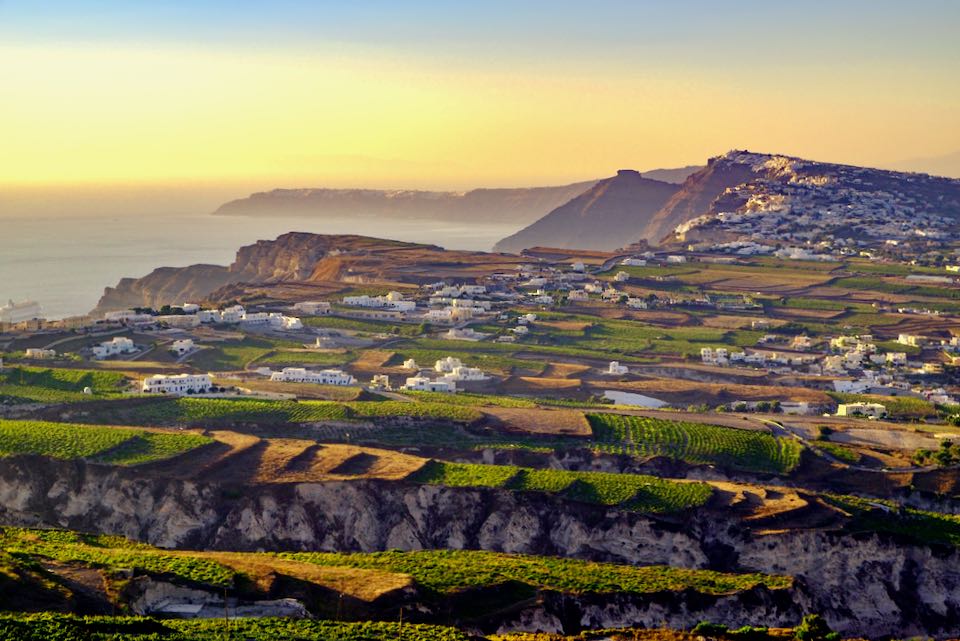
Wineries and vineyards are scattered all around the Santorini landscape.
Getting To Santorini Wineries
- Santorini buses from Fira to Akrotiri or Perissa will stop a short walk from Santo Winery, Venetsanos, Gavalas, and Boutari. (If coming from Oia, Imerovigli, or another village you’ll need to bus to Fira and then switch buses.)
- Buses from Fira to Kamari will stop a short walk from the Koutsoyannopoulos Wine Museum, Artemis Karamolegos Winery, Canava Roussos, Argyros Winery, and Art Space Winery. (If coming from Oia, Imerovigli, or another village you’ll need to bus to Fira and then switch buses.)
- Buses from Fira to Oia will stop a moderate walk from Vassaltis Vineyards and Domaine Sigalas Winery.
- Getting a Santorini taxi to and from wineries is possible, but in practice, a pretty big hassle. Uber is more practical for calling a ride from a winery.
Best Restaurant for Santorini Wines
Oia Vineyart is a hidden gem, tucked away in an old captain’s house in Oia’s quieter back streets, and the only restaurant/wine bar in Santorini offering wine from every winery on the island. The food – elevated gastronomy, locally sourced – is excellent; wines can be ordered by the glass, bottle, or in tasting flights (€35 for 6 different wines).They also maintain a deli shop selling local cheeses, cured meats and fish, and produce; perfect for a self-catered picnic or light meal. A worthwhile stop for anyone passionate (or simply curious) about Santorini’s local food and wines.
Santorini Wines
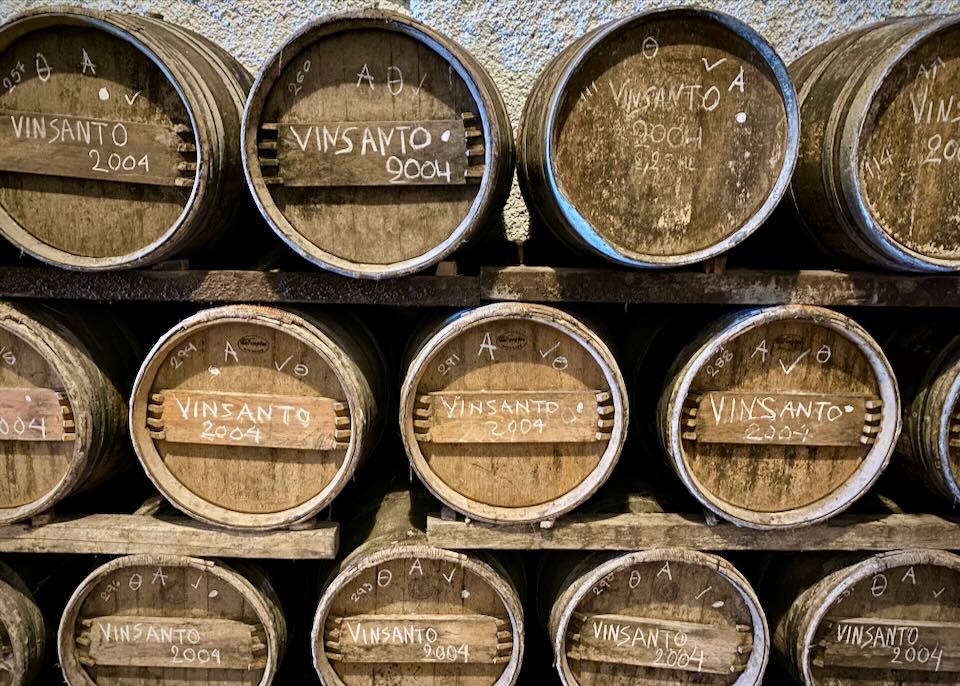
Barrels of Santorini’s famed Vinsanto wine at Hatzidakis Winery.
Santorini has plenty of quality options for wine lovers. The three most celebrated wines produced on the island are the crisp white Assyrtiko, the sweeter dessert wine Vinsanto, and the traditional white Nykteri. These wines use the Assyrtiko grape, which is indigenous to Santorini.
Assyrtiko
Assyrtiko (pronounced a-SEER-tee-ko) is considered the finest white wine in Greece, and Santorini’s Assyrtiko is the island’s best and most prolific wine. It’s also the most famous Greek white wine worldwide, and its fame is due to Santorini’s remarkable quality. Assyrtiko is a crisp, light, dry white with a hint of citrus fruits (lemon, lime, or grapefruit) and is slightly bitter. It has a definite saltiness and mineral taste. Assyrtiko is similar to a Sauvignon Blanc.
Vinsanto
Vinsanto is a dessert wine and Santorini’s oldest wine. Vinsanto is highly regarded and is extremely sweet with a dense taste and smells more like red wine, even though it’s made with the prominent white grape variety. Vinsanto has a thick, syrupy consistency and a golden color; if allowed to age, it can turn an amber color.
Vinsanto is made from late-harvest white grapes that have been dried in the sun for ten days (an ancient technique dating back to 700 BC) and then aged in oak for two or more years. This production method is complex and produces very small yields. Sometimes the wines are aged for decades, and it has the potential to age for a century. The longer the wine has aged, the more bold the flavor. Old vintages are extremely rare and expensive. Vinsanto must always contain at least 51% Assyrtiko grapes and is commonly blended with Aidiani and/or Athiri grapes. Only a handful of wineries on the island of Santorini produce Vinsanto.
Although they are both sweet dessert wines, Santorini’s Vinsanto (“wine from Santorini”) is unrelated to the Italian Vin Santo (“holy wine”). They are produced using different grapes and methods.
Nykteri
Nykteri (pronounced nith-terry) is the most unique dry white from Santorini. The wine is made from overripe grapes and then barrel-aged for at least three months. The grapes were traditionally harvested at night, hence the name Nykteri, derived from the Greek term “harvested at night.” Today, there is no requirement for the grapes to be harvested at night. There are various styles of Nykteri wine, ranging from a discreetly oaked flavor to a more full-bodied style with flavors of nuts and honey.
Santorini Grape Varieties
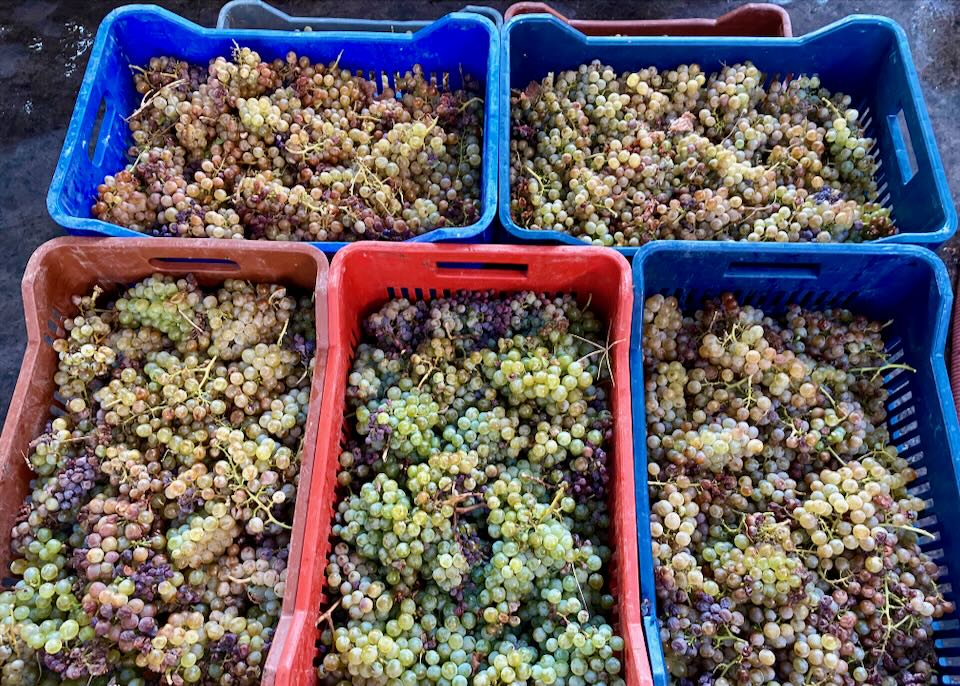
There are approximately 40 local grape varieties currently grown on Santorini, although not all are cultivated. Over a hundred years ago, there was much more diversity, and the island’s winemakers cultivated close to 60 different grape varieties. In recent years, producers have focused primarily on the top five varieties:
- Assyrtiko (white)
- Mandilaria (red)
- Aidani (white)
- Athiri (white)
- Mavrotragano (red)
The top grape, by a long stretch, is the white grape Assyrtiko, whose plantings account for 75-80 percent of Santorini’s vineyards. The next most common is the red grape Mandilaria, which accounts for about 10 percent and is typically blended with Mavrotragano. Aidani and Athiri, both whites, make up the remaining 5-10 percent; apart from a selection of rare grape varieties like Platani, Katsano, and Gaidouria.
Santorini White Grapes
- Assyrtiko
Assyrtiko (pronounced a-SEER-tee-ko) is a white Greek grape, grown all over the country and indigenous to the island of Santorini. Assyrtiko grapes have transparent yellow-gold skin, are highly acidic with fruity flavors, and produce a high alcohol content wine. Assyrtiko vines are mostly disease-resistant and do well in drought conditions. Its bark is exceptionally hard, which helps protect it from the extreme summer winds.Some vineyards in Santorini have 70-80 year old Assyrtiko vines that produce sparingly. Although the grape yields from these vines tend to be low, they are some of the highest-quality grapes grown on the island.
- Aidani
Aidani (pronounced eye-AH-nee) is an ancient white Greek grape variety found mainly on the islands of Santorini and Rhodes. Aidani is lower in sugar and acidity than Assyrtiko, with more floral aromas. Aidani is seldom used on its own and is often mixed with grapes having a high alcoholic content and acidity, such as Assyrtiko or Athiri, which helps to tame the boldness of these grapes and produces a smoother, softer wine when fermented.Although Aidani is a robust, drought-resistant variety of grape with thick skin, it’s more demanding to grow. Aidani grapes ripen at different times, so the grape harvesters have to pick some grapes first, then pass through the vineyard a second time to collect the remaining grapes. Additionally, Aidani ripens late, so it must be harvested last – which is not easy when it’s planted alongside other types.
- Athiri
Athiri (pronounced ah-THEE-ree) is grown exclusively in Greece, and is known for its fruity flavors with hints of citrus like lemon, grapefruit, and nectarines. It is primarily used for blending with the dominant Assyrtiko. Athiri’s acidity is much lower than Assyrtiko, and the grapes are thin-skinned, with a golden-green appearance. Athiri grapes are generally easy to grow and therefore produce high yields.Santorini Red Grapes
Mandilaria is the most widely planted red grape variety on Santorini. While Mavrotragano is an ‘exotic’ grape variety that’s making a comeback after it was near extinction on Santorini around 2008.
- Mandilaria
Mandilaria (pronounced Man-dee-LAR-ya) is a black-skinned red grape, also known as Amorghiano (on Rhodes), and the most widely planted red grape variety on Santorini – though growers tend to produce small yields. Mandilaria grapes have very thick skins full of tannins, which account for the most intense colorations in Greek wine, and are high in antioxidants. Wines from this variety have a low alcohol content, however, and typically lack intense flavor and aroma, so Mandilaria is frequently used in blends.- Mavrotragano
Mavrotragano (pronounced Ma-vro-TRA-ga-no) means “black and crunchy” in Greek. Producing a small fruit with high sugar levels, Mavrotragano grapes produce spicy, deeply colored, full-bodied red wines that are similar to a Syrah. Most producers on the island feature a 100% dry Mavrotragano, although in very small quantities.Mavrotragano was traditionally used to make sweet wines, but came close to extinction on Santorini a couple of decades back. In the 1970s, most of the island’s Mavrotragano plantings were replaced with Assyrtiko, the dominant and more lucrative variety. Since its low point around 2008, however, this little grape has been making a comeback, returning in very limited plantings cultivated by a few of Santorini’s most dedicated growers. For this reason, Mavrotragano is considered ‘exotic’ — a rare variety covering only one percent of the total plantings on Santorini.
Excessive alcohol levels in this variety can be problematic if winemakers are not careful. Another challenge with this grape is that fully ripe bunches often include underripe green berries. Winemakers in Santorini continue to experiment with growing techniques to maximize this grape’s potential in wines and wine blends.
Rare Varieties
Once upon a time, the island’s vineyards grew over sixty varieties, however most of these varieties are no longer grown. Platani, Katsano, and Gaidouria grapes continue to be cultivated in very small amounts, and a few wineries are producing some unique blends using these fruits. Wines made with Katsano and Gaidouria do not have the pronounced acidity of Assyrtiko, but retain the salty mineral taste.
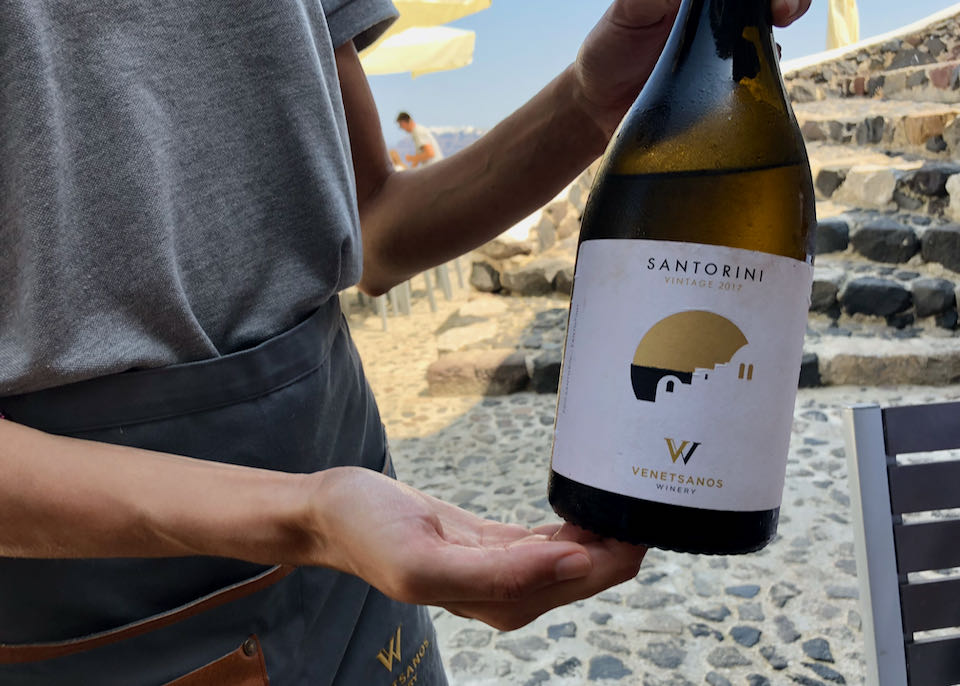
The Small Group Santorini Wine Tour visits multiple wineries, including Venetsanos – one of my favorites.
Santorini Grape Growing Conditions
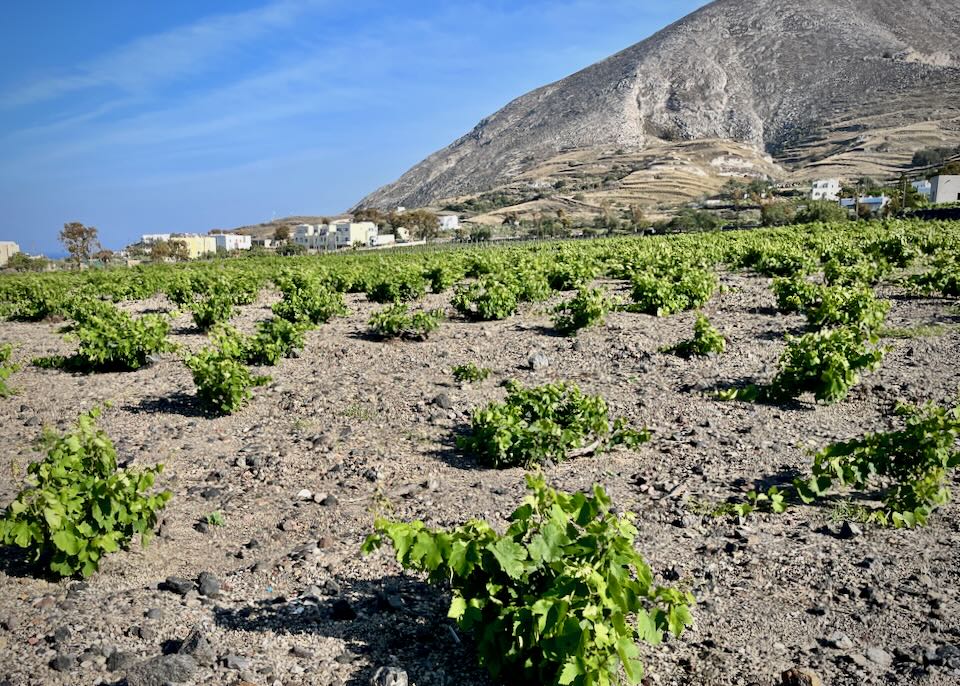
Grapevines at the Argyros Estate vineyards in Episkopi Gonia.
Soil
Santorini’s soil, formed from the island’s major volcanic eruption in 1600 BC, is a mix of volcanic rock, ash, sand, pumice, and lava fragments, known locally as “aspa.” This composition makes the soil acidic with a low pH, influencing the mineral taste of the local wines. The soil, light and crumbly, retains little moisture and is not suitable for tilling. Its appearance resembles a blend of sand and lunar pebbles in red, black, or white. Vine roots here can extend up to 20 meters deep, seeking nutrients from the volcanic ash embedded deep in the soil.
Intense Sun & Wind
Summer in the Cyclades, including Santorini, is typically very sunny with very few cloudy days. The region experiences strong northern Meltemi winds from May to September, which can challenge wine production by risking grape damage. However, these tough conditions are also thought to enhance grape quality, producing better juice and superior wines.
Rain & Sea Mist
Santorini experiences minimal rainfall from April to September, with almost none in summer. Grape vines are irrigated only in their first one or two years; thereafter, they rely on moisture from the volcanic soil. At night, sea mist from the caldera blankets the island, supplying essential moisture to the vineyards. The island’s unique, porous, pumice-rich soil effectively absorbs and then gradually releases this moisture to the vines, providing an optimal amount of water for the grape crops.
What is Terrior?
Terroir (pronounced teh-waar), derived from the Latin terra meaning soil or land, refers to the natural environment of a vineyard, including soil, climate, rainfall, and terrain. It’s the concept that the specific location where wine grapes are grown imparts a unique flavor to the wine, creating a distinct “personality” that cannot be replicated elsewhere, even with the same grape variety and winemaking methods. Essentially, terroir embodies the “taste of a place.”The vineyard at Hatzidakis Winery in Pyrgos.
While primarily associated with wine, terroir also applies to other soil-grown foods like olives, tomatoes, and hops, where the growth region contributes to their distinctiveness.
Santorini’s Unique Growing Style
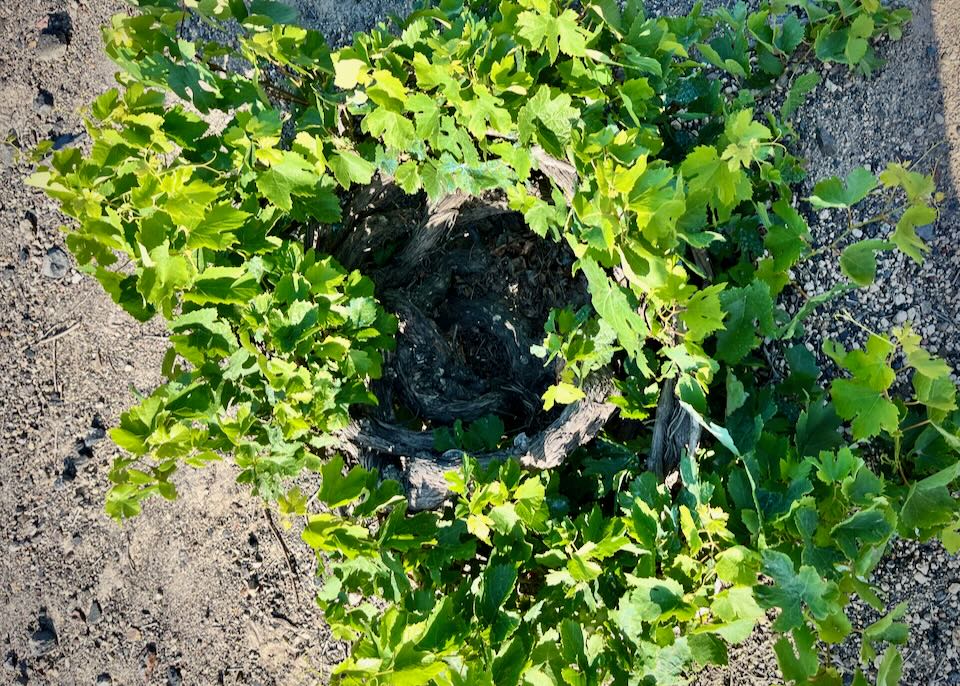
The traditional kouloura-trained grapevine on Santorini resembles a living basket. This vine is at Argyros Estate winery.
In Santorini, vines are grown low to the ground and are not supported by wire trellising, as is common in most vineyards throughout the world. In order to provide necessary protection from the island’s harsh conditions, local growers have adopted special training systems for the vines:
- Kouloura (Basket) Method
The most common method, where grape-bearing branches are carefully woven by hand into a circular, wreath-like shape. This living ‘basket’ shelters the grapes from strong winds, intense sun, and dry climate, while also trapping humidity. Typically, trapping the humidity is generally not a good wine-making practice, but it is beneficial in Santorini’s extremely arid environment.- Kladeftiko (Small Ring) Method
In this method, vines are shaped like goblets with pruned branches forming a spur at a lower point and longer canes trained into a circle higher up. In spring, the ring will grow shoots and bear fruit, parallel to the trunk. This age-old practice creates a taller trunk which facilitates better aeration, as the grapes are off the ground, unlike in the kouloura method. However, they are also more exposed, which makes this method suitable only in wind-protected areas.Additionally, terraced landscaping and traditional Greek dry-stone walls are used to enhance cultivation and reduce water loss.
Harvesting
In Santorini, grape harvesting is time-consuming and labor-intensive; mainly done while crouching, as the vines are low to the ground. Vines are widely spaced in the vineyard to optimize the absorption of scarce nutrients. Harvesting is always manual or assisted by donkeys, with no machinery involved.
Santorini grape harvest.
Wine Classifications – PDO and PGI
PDO stands for Protected Designation of Origin.
Greece has more than 100 products that have been registered as PDO, including wine, cheese, olive oil, honey, and more. When a wine is labeled as “PDO,” this indicates that the wine comes from a specific area, is produced from designated varieties, and is made using that location’s traditional wine-making techniques.
The PDO Santorini classification guarantees the wine will be made using at least 85% Assyrtiko grapes, with the remaining percentage made up of Aidani and/or Athiri grapes, all grown in the PDO zone of Santorini. All stages of the wine production must take place within the Santorini zone, including grape cultivation, fermentation, and bottling and labeling. The designated PDO Santorini zone consists of Santorini (Thira) and its closest neighboring island, Thirassia.
PGI stands for Protected Geographical Indication.
When a wine is labeled as “PGI,” this indicates that at least 80% of its grapes have been grown in that particular zone. The rules regarding production are much more relaxed than the PDO designation, and only one stage of the overall production must take place within the specified zone.
The PGI Cyclades Islands zone includes all of the Cycladic islands located in the Aegean Sea. Grapes used to produce PGI Cyclades Islands wines must be planted at altitudes exceeding 30 meters. Most wine made in the Cyclades Islands PGI zone comes from either Santorini or Paros.
Santorini Hotels for Wine Lovers
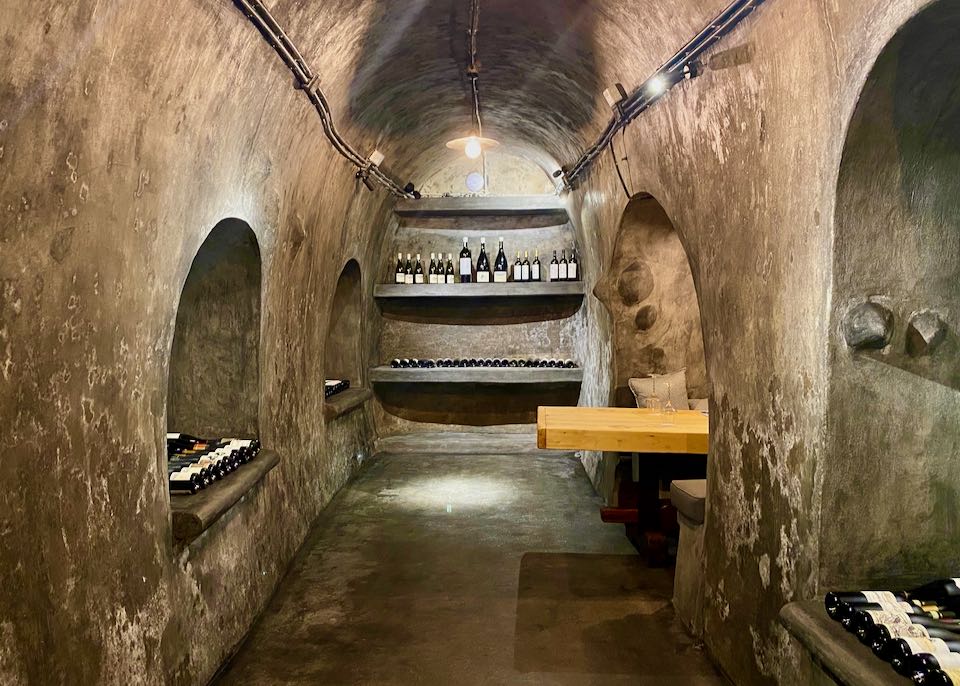
The wine cellar at Akra Suites in Imerovigli.
Hotels of Note
- Akra Suites (Imerovigli): Charming wine cellar for tastings.
- Anatoli Hotel (Fira): Set in former winery and distillery.
- Angel Luxury Suites (Fira): Attached to a popular wine bar.
- Atrina Canava 1894 (Oia): Set in a former wine cave.
- Canaves Ena (Oia): Wine tastings offered on site.
- Charisma Suites (Oia): Offers a sunset champagne event every night, free for guests.
- Heliotopos (Imerovigli): Popular wine bar for sunset viewing.
- Katikies Garden (Fira): Their centuries-old canava formerly used to store the pope’s wine, 3 wine cellars currently on site.
- Katikies Kirini (Oia): Offers daily sunset wine tastings.
- Kapari Natural Resort (Imerovigli): Wine-themed restaurant on site.
- Nous (Mesariá): Offers wine from every winery on the island.
- Perivolas (Oia): Hotel restaurant is in an old wine canava.
- The Vasilicos (Imerovigli): Same owners as Vassaltis Vineyards; wine tastings, pairings, & tours offered.
- Vedema (Megalochori): Located in the heart of the wine country, offers tastings in their cellar.
Santorini Wine History
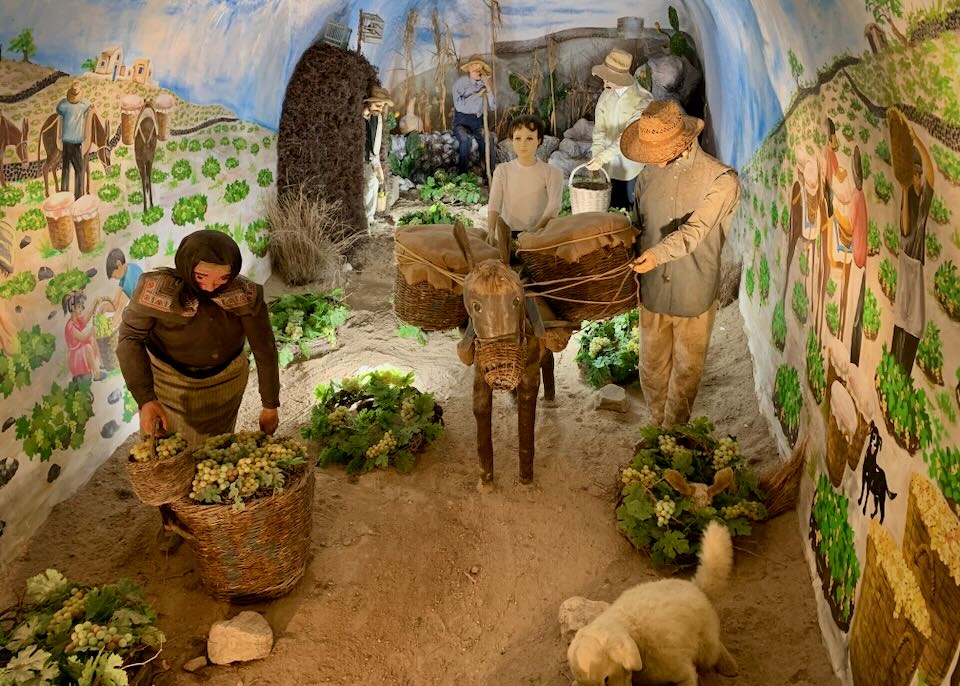
The underground cave museum at Koutsoyannopoulos Winery is full of artifacts, photographs, and dioramas that illustrate the history of viticulture on the island of Santorini.
The iconic and picturesque caldera of Santorini was formed following a massive volcanic eruption around 1600 BC. The eruption left the island, engulfed in volcanic debris, lifeless and barren for three centuries until settlers arrived around 1300 BC. These settlers introduced vine cultivation in the volcanic soil.
From 500 AD to 1500 AD, Santorini’s sweet wines, traded as “vin Santo” (wine from Santorini), gained popularity, leading to the contemporary name “Vinsanto” for these wines. During this era, the island’s dry Assyrtiko wines were far less favored than the celebrated Vinsanto.
In the late 1800s, phylloxera (pronounced fi-lok-SUH-ruh), a tiny aphid that is devastating to vine roots, ravaged vineyards across Europe, including in Greece – but spared Santorini due to its unique volcanic and sandy soil, which lacks the clay necessary for the pest’s proliferation. As a result, Santorini’s vineyards, some centuries old, have maintained their natural root systems. Some of the island’s vines are believed to be over three hundred years old.
In the late 19th Century, European wine crops were decimated by phylloxera insects. Santorinian vineyards were immune to this blight, however, as the tiny pest cannot survive in the island’s volcanic soil.
While phylloxera was controlled in Europe by early 1900s, Greece’s wine industry suffered due to World Wars, leading to a total collapse of commercial wine production in the Cyclades. Santorini’s vineyards essentially became dormant. However, by the early 1950s, grape vines were flourishing all over Santorini, with over 4,000 hectares used for this purpose.
Since the heyday of the 1950’s, however, Santorini’s vineyards have steadily dwindled; dropping to about 2,000 hectares in 1980, and then to merely 1,100 in 2025. This reduction is attributed to tourism-driven development, the challenge of finding vineyard labor due to high living costs, and the profitability of selling land to developers.
Since the 1950’s, Santorini’s tradition of wine production has been threatened by modern day tourism.
By the late 1980s, there were only six wineries on Santorini: Santo, Venetsanos, Koutsoyannopoulos, Canava Roussos, Boutari, and Markezinis — which no longer exists as a winery, having since been converted to cave-style accommodations. Since the turn of the century, however, Santorini’s wine industry has seen remarkable growth, with the development of new wineries and the modernization of some traditional canaves or underground wineries. Over the last forty years, the island’s total number of wineries has grown by over 200%. As of 2025, Santorini hosts twenty-one wineries, which is encouraging growth amid concerns that mass tourism might threaten the wine industry’s future.
Books on Santorini Wine & Wineries
The Wines of Santorini by Yiannis Karakasis is a joy to read and wonderfully informative about every last detail regarding Santorini wines. It’s a little tricky to find but if you get the chance do grab a copy.More recommended books on wine and viticulture
- Volcanoes and Wine: From Pompeii to Napa, by Charles Frankel
- The World Atlas of Wine, by Jancis Robinson
- Wine Folly: The Master Guide, by by Madeline Puckette & Justin Hammack
Read More
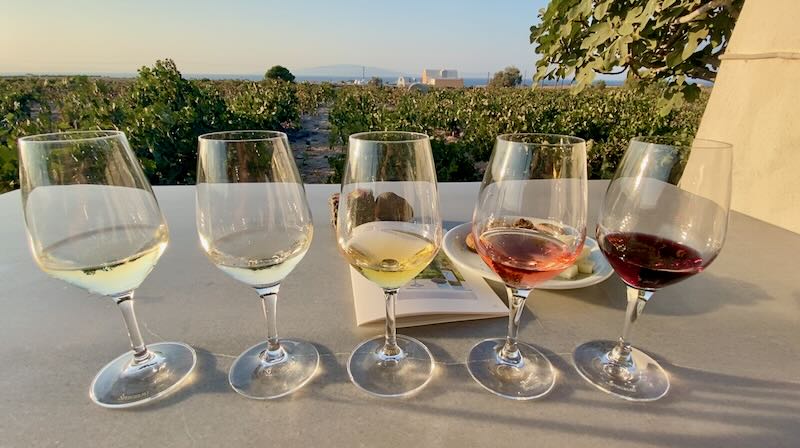
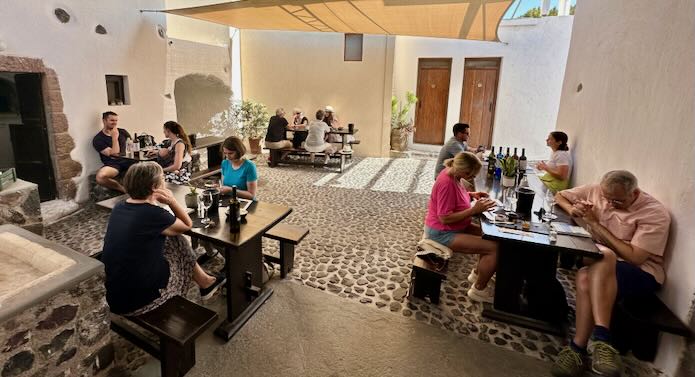
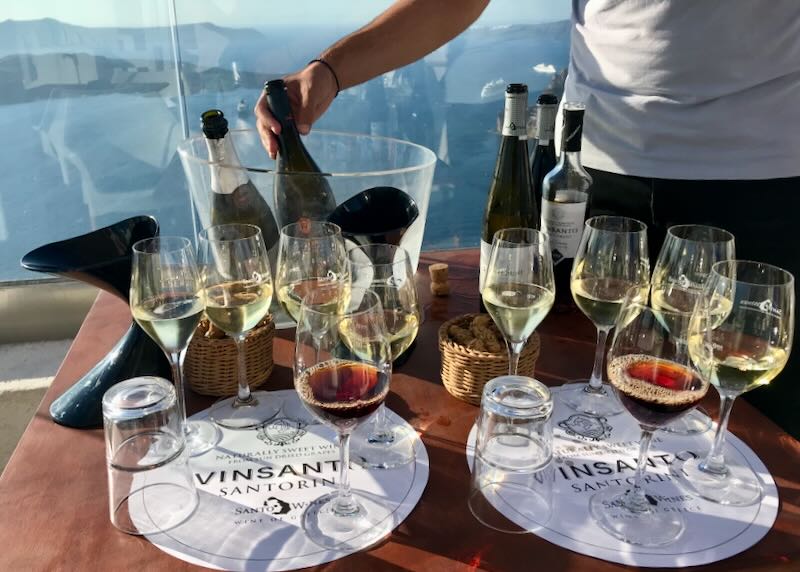
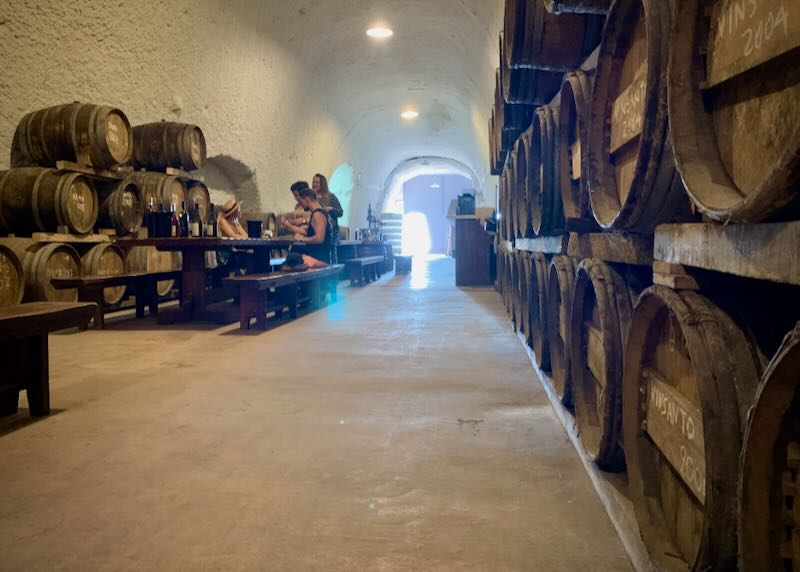
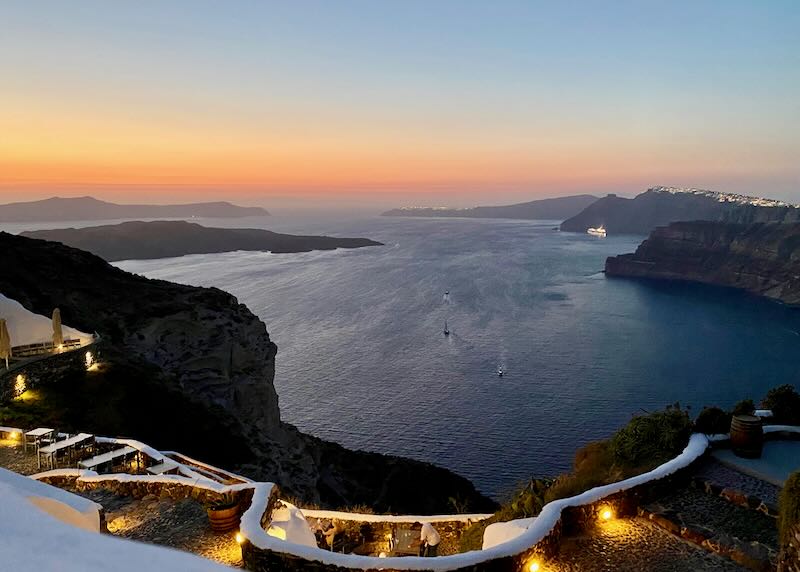
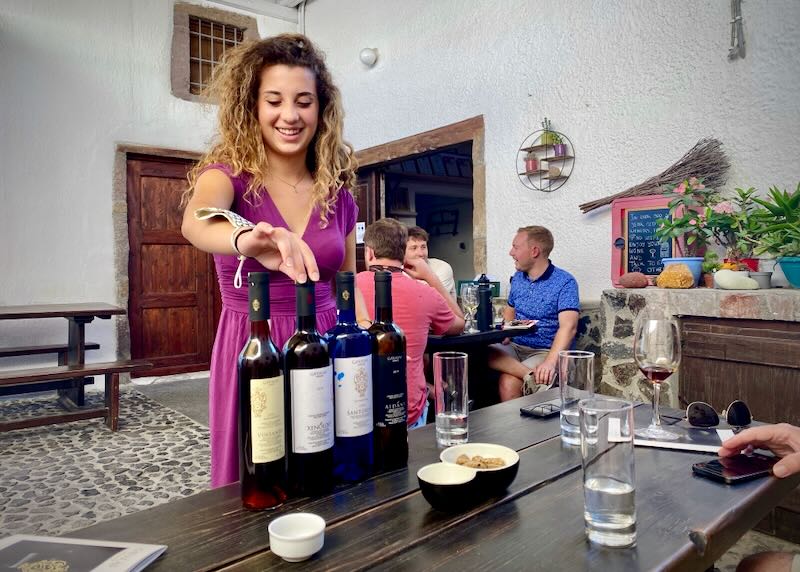
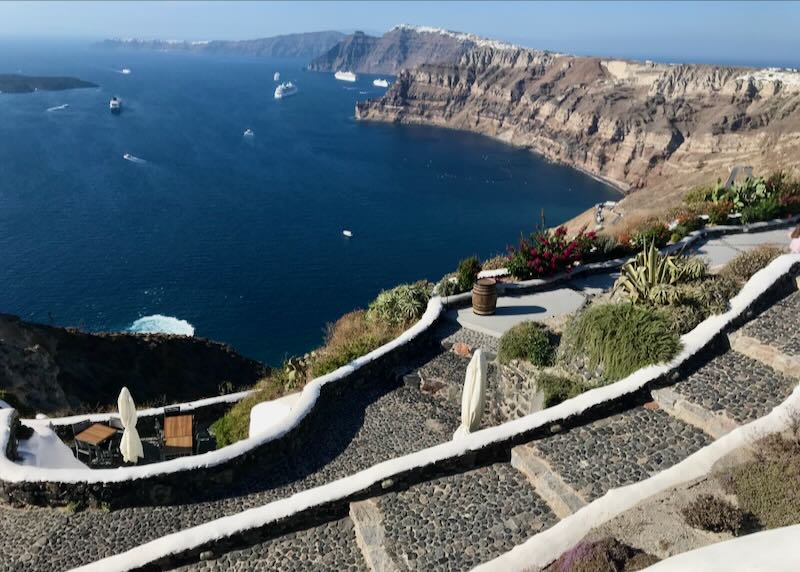
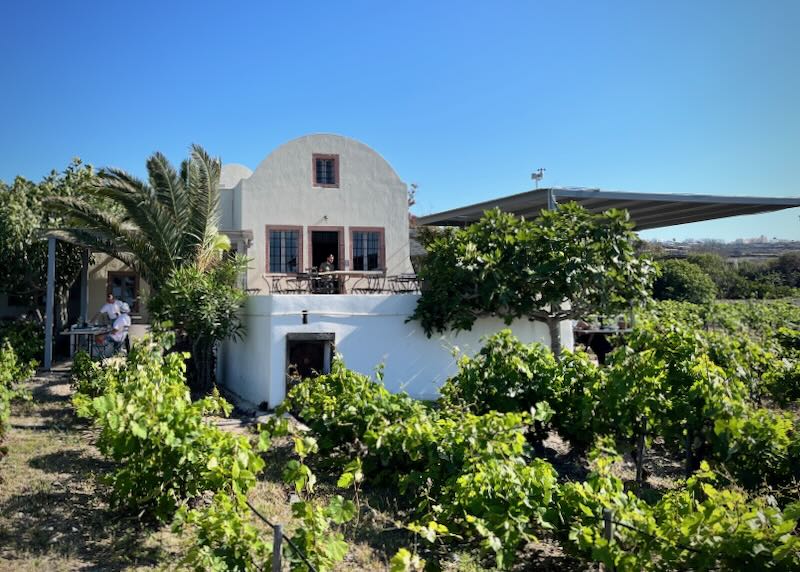
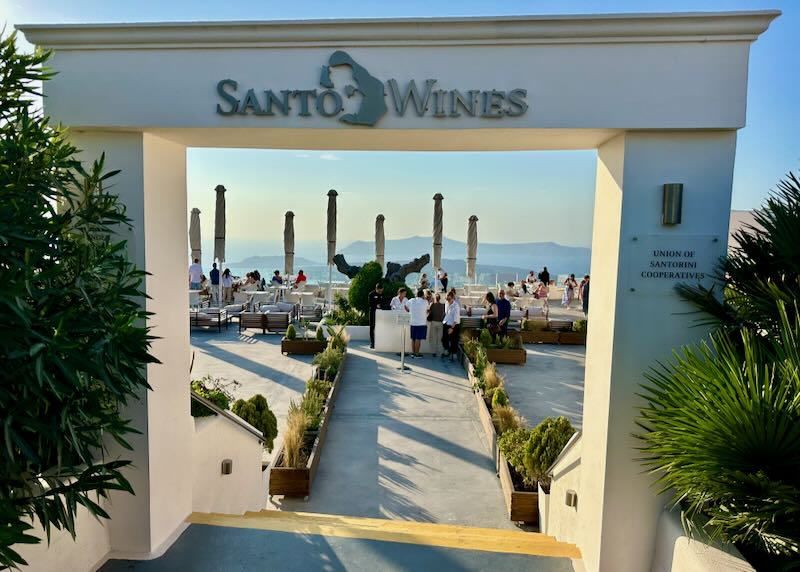
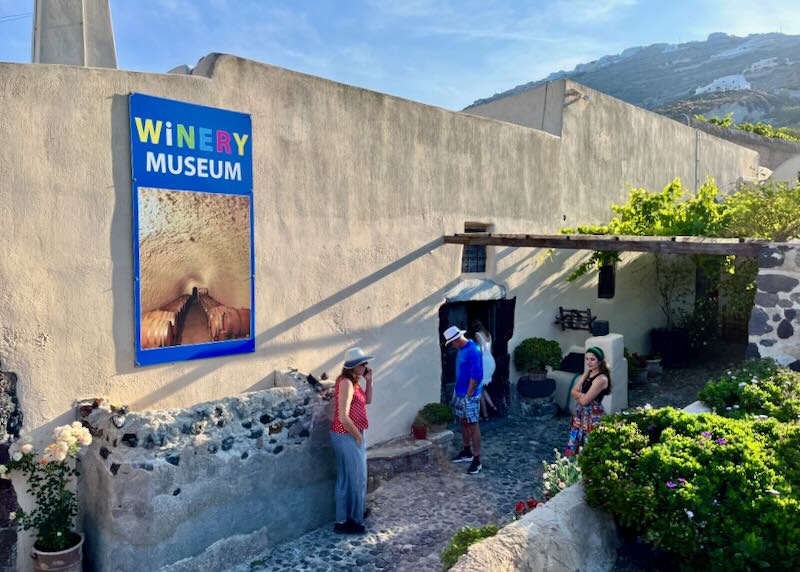
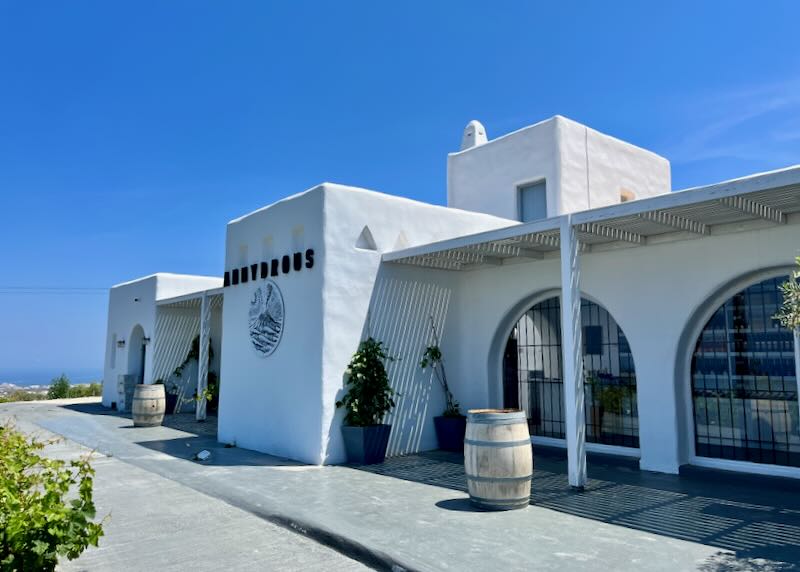
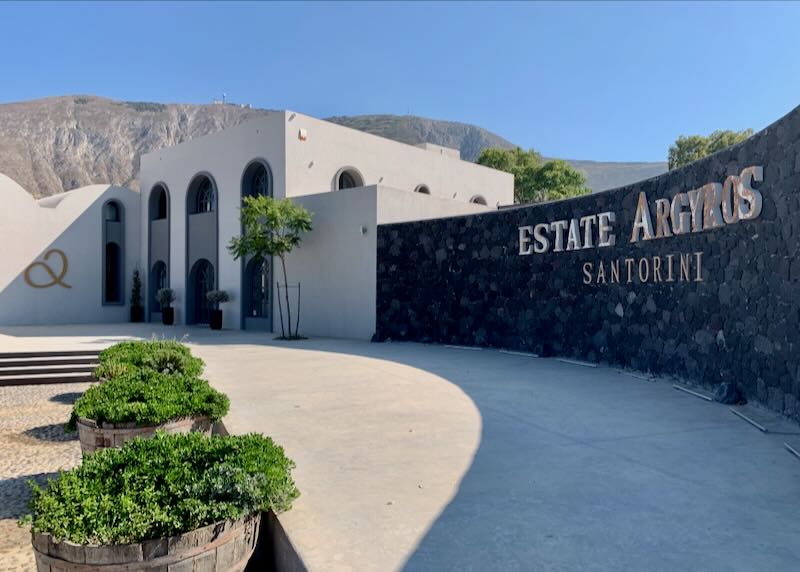
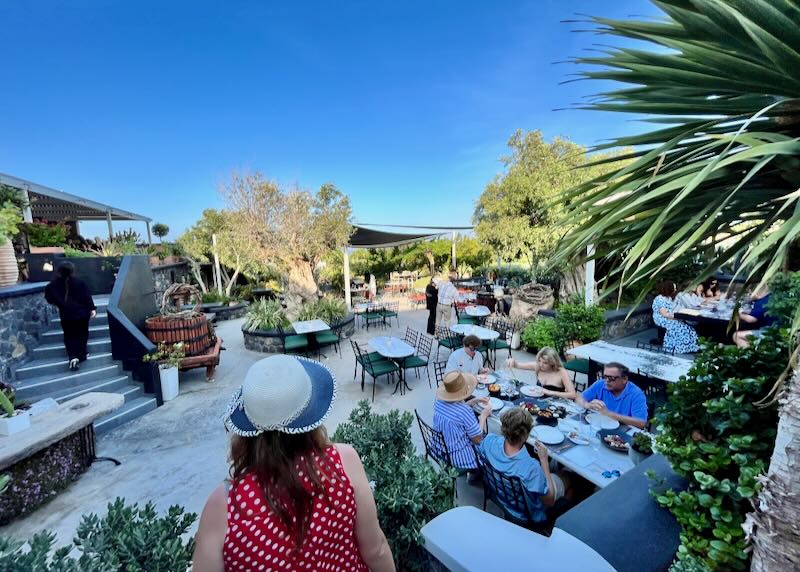
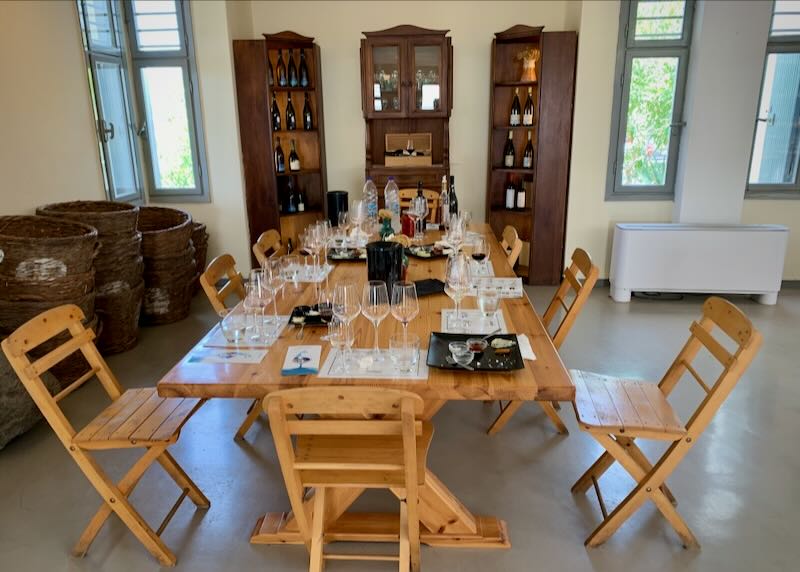
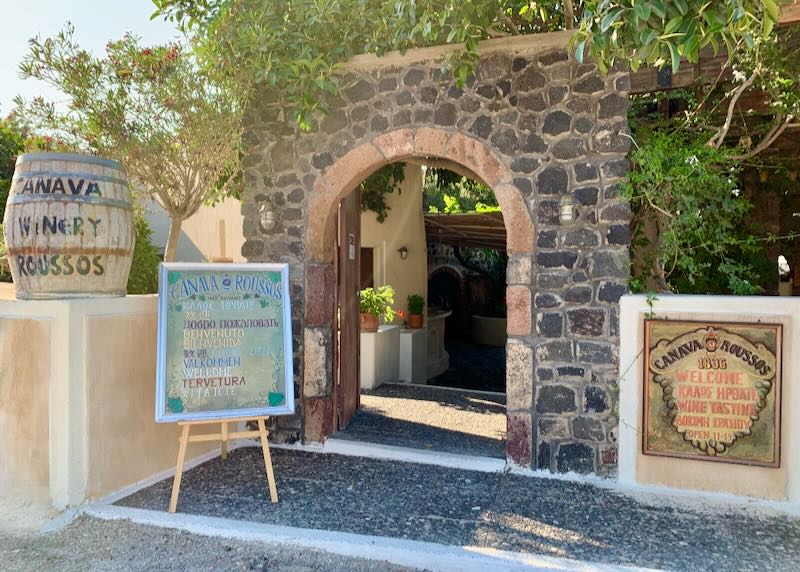
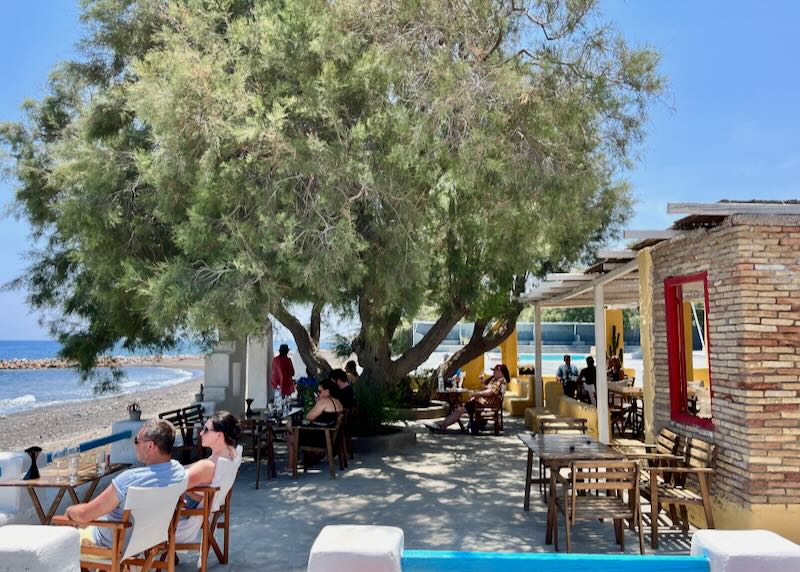
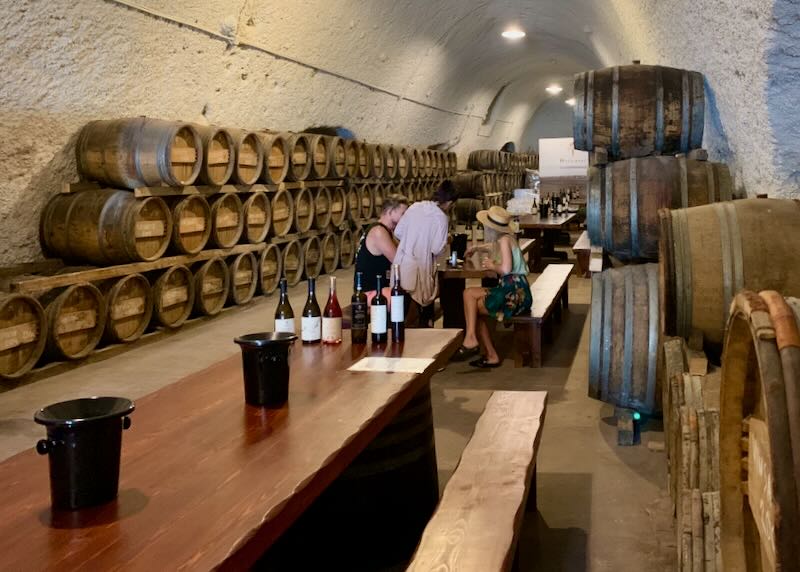
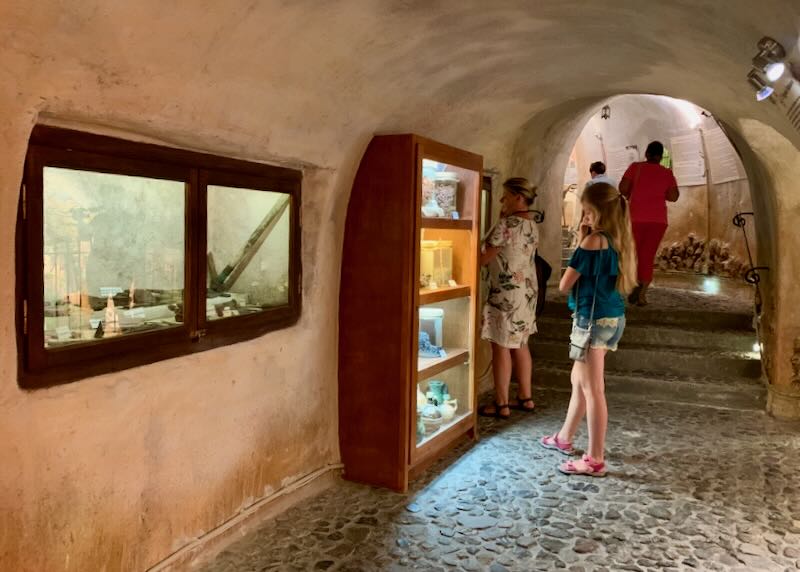
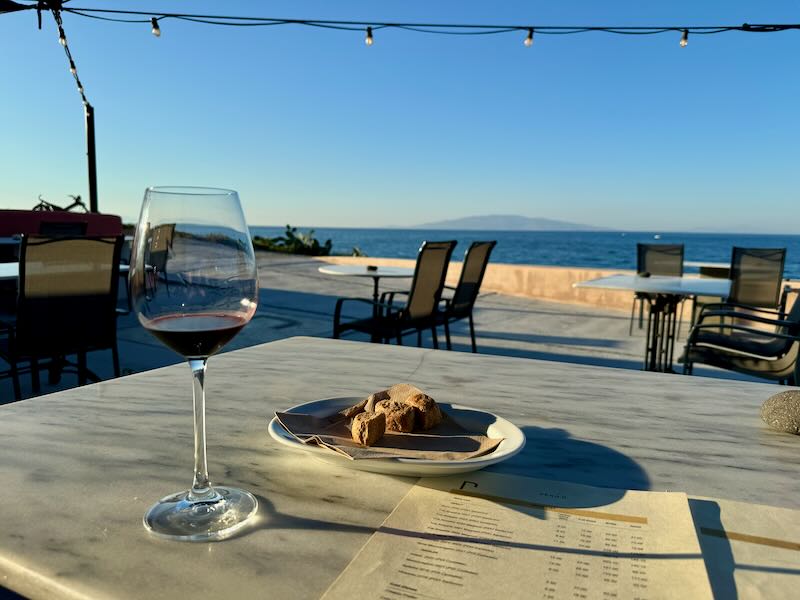
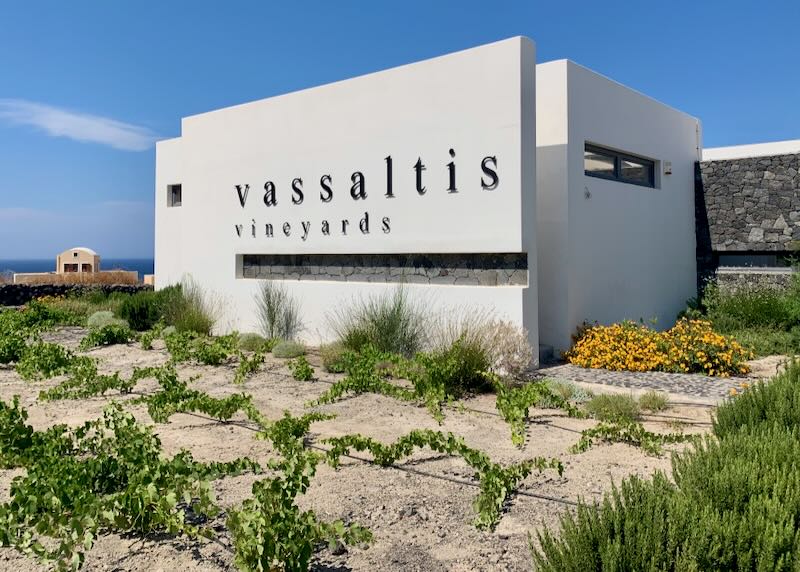
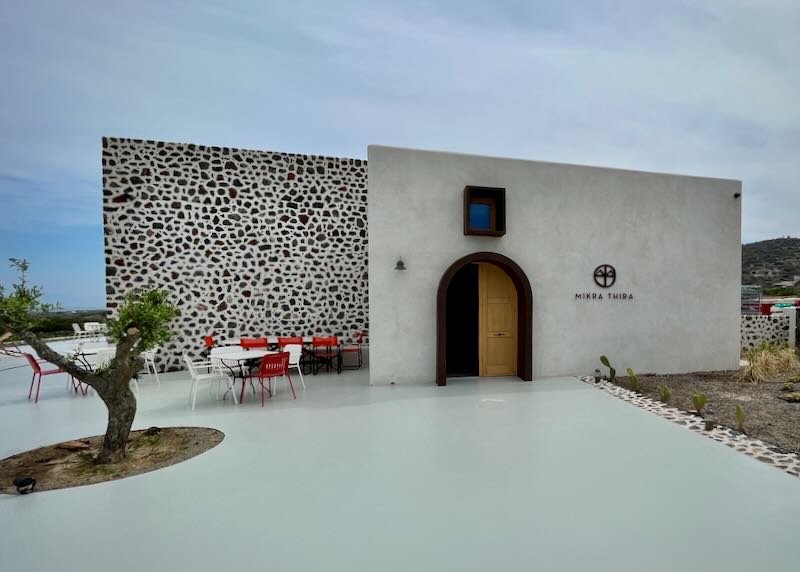
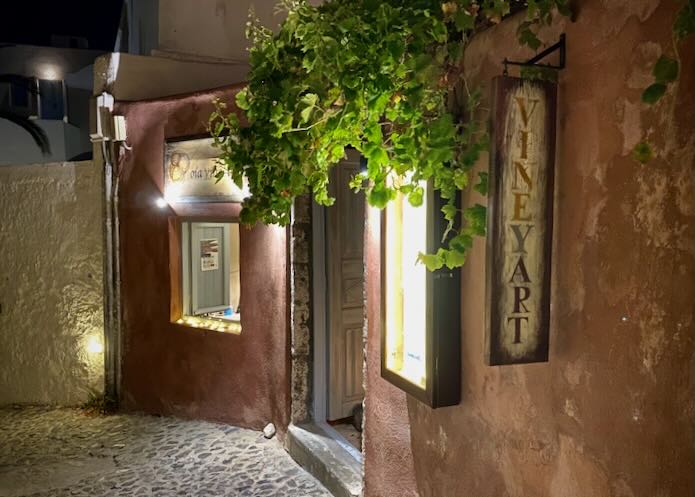
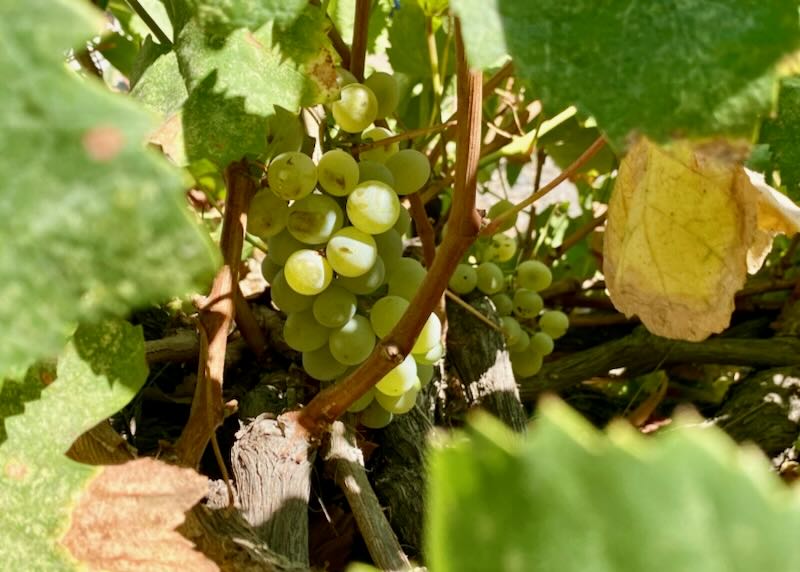
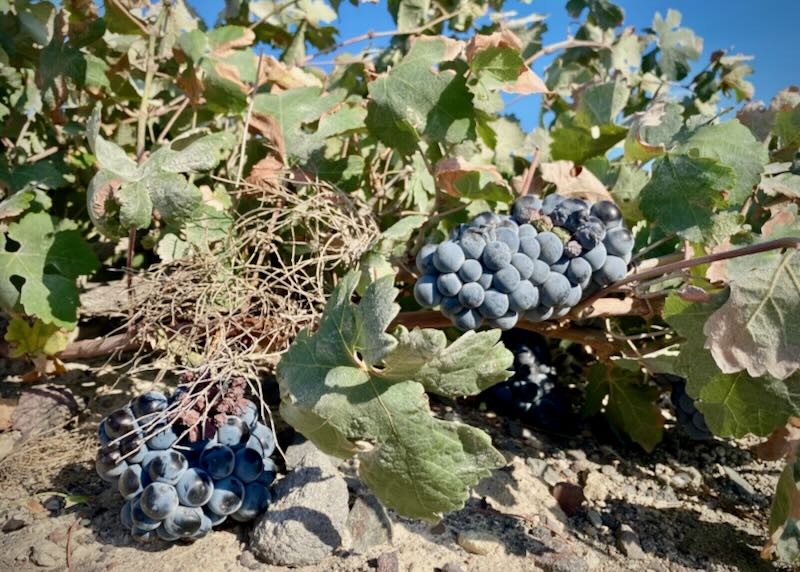
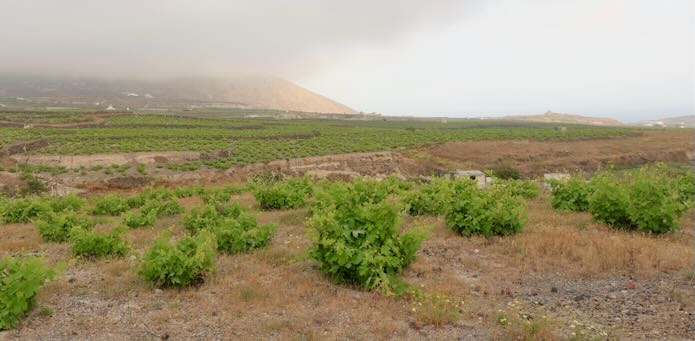
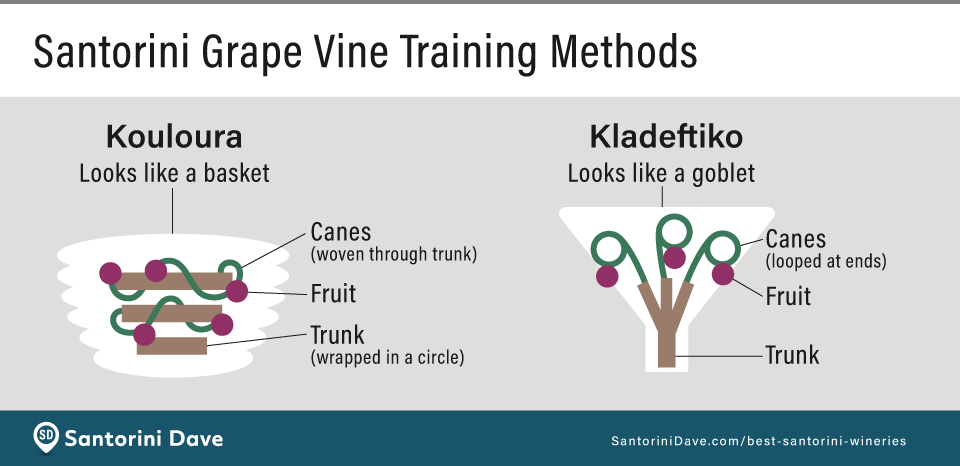
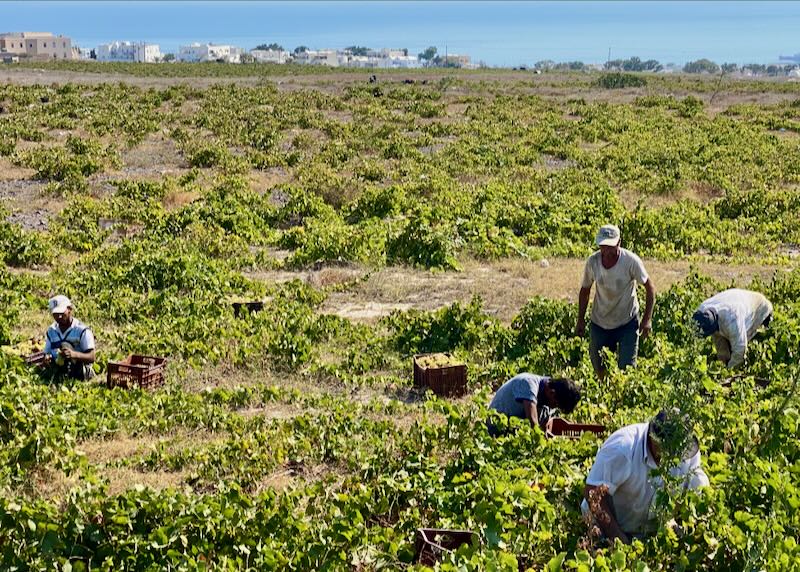
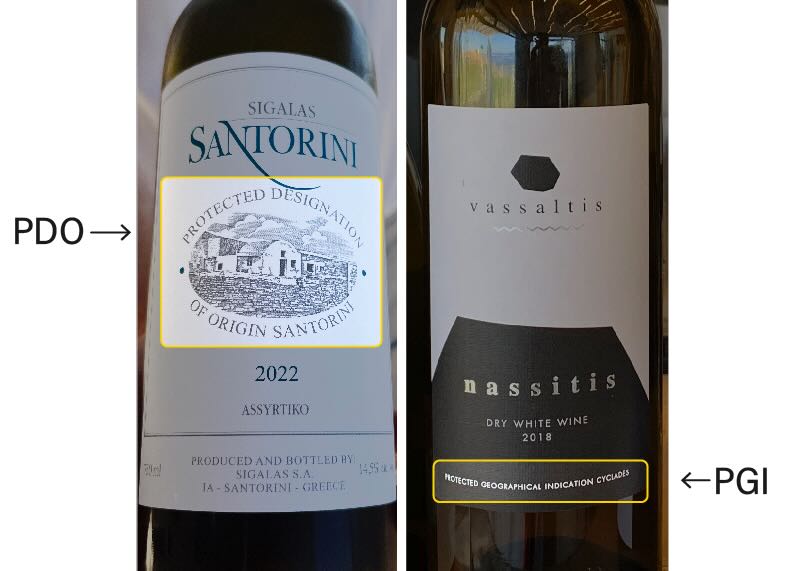
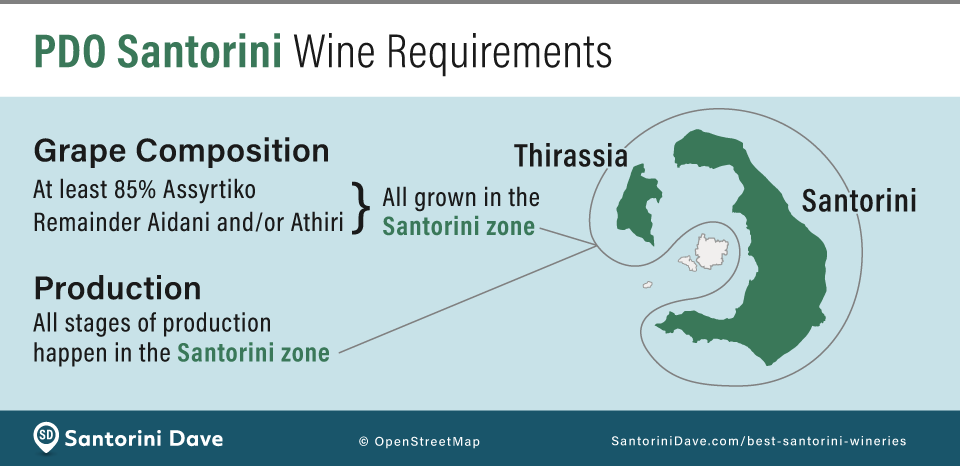
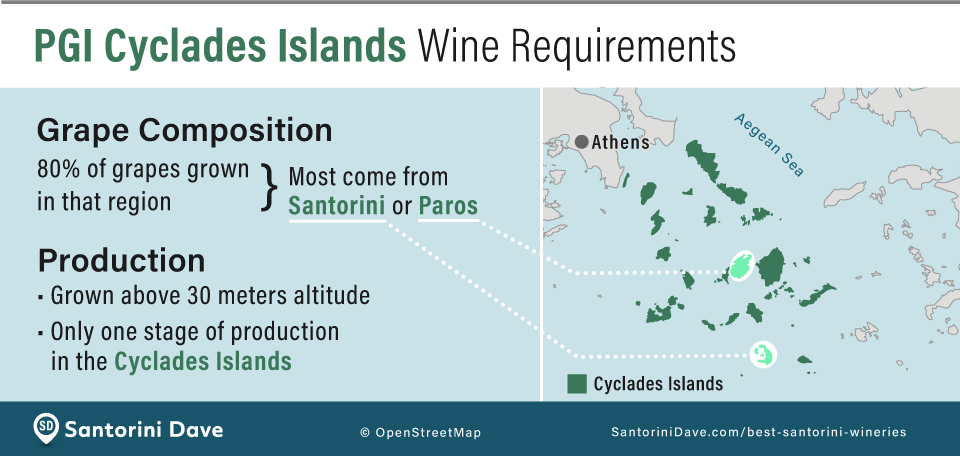
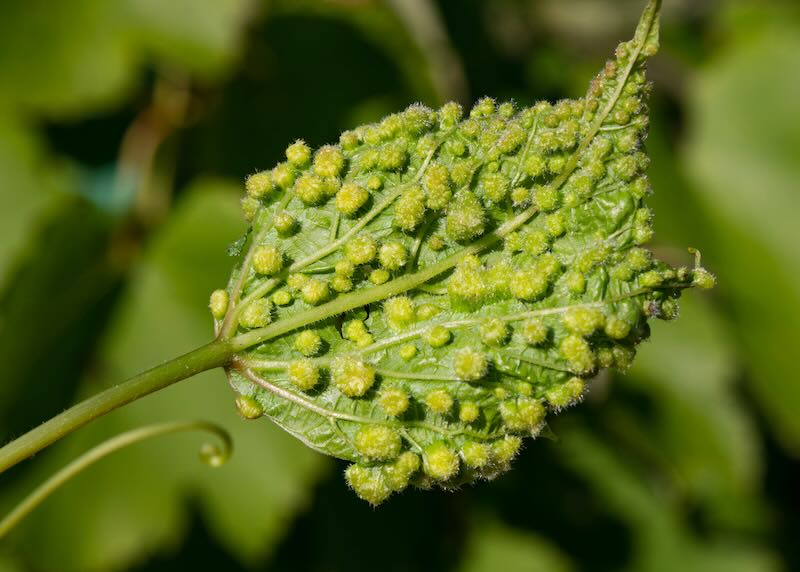
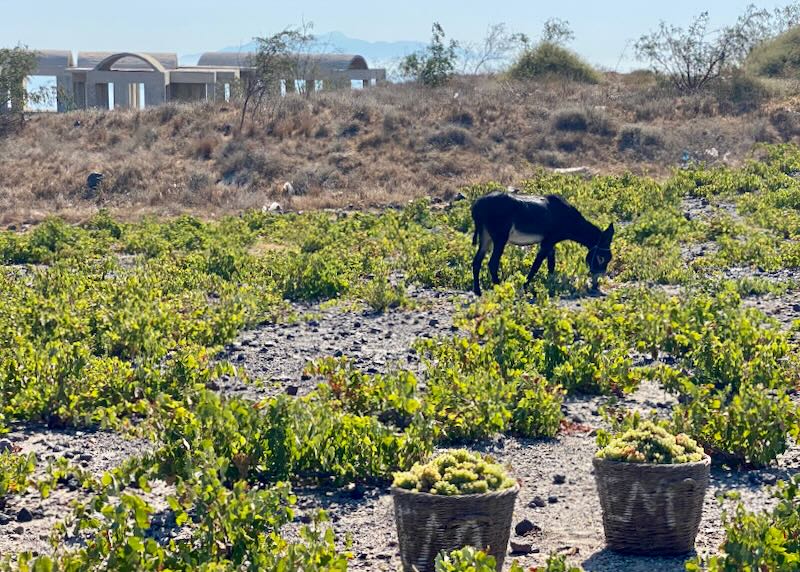
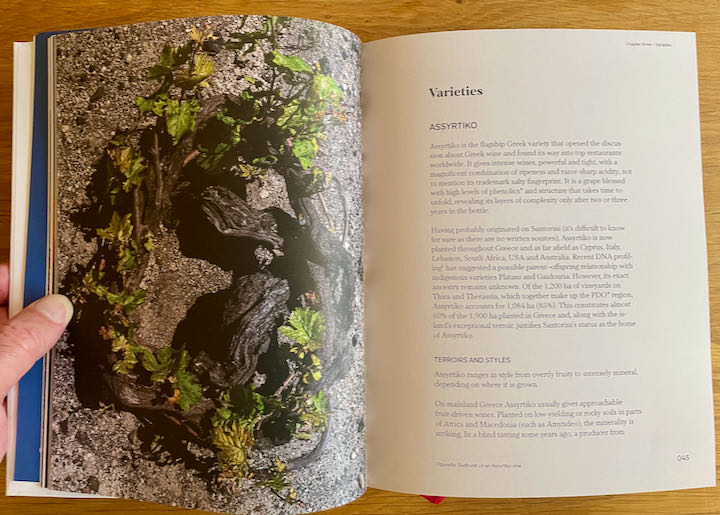
 Santorini Dave was started in 2011 when I posted a short guide to visiting Santorini with kids. Now, my site publishes regularly updated guides to
Santorini Dave was started in 2011 when I posted a short guide to visiting Santorini with kids. Now, my site publishes regularly updated guides to
Thanks for all the great information. Can we get from Santo Winery to our cruise ship if we leave Santo at sunset? The itinerary says 10:00 pm for the cruise ship to leave. Thanks!
The time of sunset varies by time of year. I trust you’ve looked this up. So, by what time should you leave Santo Wines? If you were getting in a taxi to head back to Fira at 8:00pm I think you’d make your cruise’s departure. But there are many variables. How long does it take to get a taxi to arrive at Santo? How long is the line at the cable car? Personally, I would visit Santo through the day and then return to Fira and watch the sunset from one of the bars just a short walk from the cable car. I hope that helps.
If we want to do our own tour of the wineries, like Santos, Venetsanos and Boutari, how would be the easiest way to get there and visit all 3. Will we need to use taxi or is there buses?
Thanks
There are bus stops pretty close to all 3 of these wineries. So getting to any one of them and then returning from any one of them is fairly easy. However, getting between them is much more of a hassle. And calling for a taxi can be a long wait, if they come at all. If you want to visit more than one winery I would do a tour or hire a driver for the day.
Wonderful website with tons of great info! Thank you!
Just returned from Santorini and loved the visit at Estate Argyros. Wines and hospitality were both top notch! From there it was an easy drive over to Metaxy Mas for lunch. I think the whites at Argyros are among the best on the Santorini.
John Osgood
Thanks John. I’m happy it was helpful.
Sadly, all wine tours are sold out for our visit in 3 weeks. We have decided to spend our time doing a boat tour, hike, and Akrotiri but would like to visit at least one winery. Which would you choose for a quick one-hour stop: Venetsanos or Santo Winery. Thanks.
In my opinion, both have great views but Venetsanos has a little more charm. Santo has a better (larger) wine shop – if you’re looking to take some wine home (or get it shipped).
Hi,
Your site is helpful. Are there any wine tours in the off season? We are visiting in February and can’t find any availability. Thanks.
There are combo sightseeing and wine tours (like this one) available in February.
My problem: No availability left for Wine Tours.
Hi Dave,
Love your website and has been super helpful planning my trip. I just booked a solo trip to Greece and will be staying in Fira for 2 and half days. I would love to do a wine tour but it appears that everything is either totally booked up already or requires multiple people to take part. Are there any wine tours that allow solo travelers that are still available to book and if I wanted to plan a DIY tour what would your recommendation be? (Time of day, vineyards to see, walking or renting a driver for a few hours). Lastly if I were to do a DIY tour stopping at 3 vineyards for tasting what would that estimated cost be? Thanks!!
Yes, wine tours get fully booked earlier and earlier every year.
For a DIY wine tour I’d start at Venetsanos Winery (buses go nearby on their way to Akrotiri or Perissa). Then walk to Gavalas Winery in Megalochori. It’s less than a 15 minute walk and it’s a little tricky because of the lack of sidewalks but still pretty easy and doable. If that sounds unappealing you could call a taxi but you might be waiting a while. Those are two of my favorite wineries in Santorini. If you needed a third keep walking (sort of south and west) to Boutari about another 10 minutes south of Gavalas. Then bus back to Fira. As for costs it’s very hard to say as each winery offers a wide range of tastings.
Hi Dave,
Thanks for all the information on wine tours! Regarding to answer on a DIY tour, I wanted to follow-up to your answer to a previous poster. We’ll be staying in Megalachori, and are interested in doing our own mini-tour starting at Gavalas, and then walking to either Venetsanos or Boutari (which both seem to be semi-close?). Which would you recommend, and about how far is the walk?
Thank you!
Danielle
I’d say, go to Venetsanos for the views (awesome) and setting. Go to Boutari for the wine. Not that there’s a huge difference in quality but Venetsanos does get more people interested primarily in the views. Boutari is sort of ugly and attracts more serious connoisseurs. As to walking, it’s a little tricky but doable and not far (walking along the busy road is more of the problem). If possible scope out both places beforehand (in a car, if you have one) which will make finding them on foot easier.
Hi Dave,
We would like to book for a tour online for November, but I can’t for some reason. Are the tours full or closed for the season?
If so can we do it in the island? Or do you recommend just walk in the winery? Our plan is on November 14-18.
Thank you
Mark
This private wine tour of Santorini will typically have availability in November.
We’d like to visit a winery near Oia during our visit in December. I see Sigalas is within a short drive of Oia. Is it open in December and will we be able to visit?
Sigalas usually closes in early December. But if you contact them they’ll open up, give you a quick tour around the grounds, and let you taste and buy some wines. Send them an email at sigalaswinetasting@gmail.com or call Panayiota at +30 6982 877912.
Hi Dave, many thanks for all of the useful information your site provides. It’s been incredibly helpful for planning my trip over the last few months! I will be staying in Santorini for 6 days, what are the benefits of doing a wine tour as opposed to visiting on your own? We have rented a car for our stay. Look forward to hearing from you!
Jessica
The biggest advantage is you can enjoy the wine without having to worry about drinking too much. The pours are usually generous and it’s not hard to feel tipsy after a winery or definitely two. Also, finding the wineries can be a challenge. And the tours offer good info on the winers, wineries, and how the grapes are grown that you wouldn’t get without the tour. But can you do it yourself? For sure.
Dave, you’re a legend. Thanks a million for all this info. My wife and I are going to Santorini in a couple weeks and would like to do a wine tour. We prefer red wines to the dessert-ey whites but I’m noticing there are mostly white wines that are popular. Do you recommend any wineries or wine tours that have mostly reds? Thanks in advance.
The best wines on Santorini are whites so I’d encourage you to focus on them even if your tastes tend in a different direction. If you do want to try some reds then Gavalas Winery has the best red wines in Santorini.
After reading your review on Santo Winery and seeing the views, we are hoping to select a sunset tour that includes this winery. However, on the linked “Santorini Half-day Wine Tour” above from GetYourGuide, it does not specify which wineries will be visited. Are you fairly certain that Santo Winery is usually on that tour route? I messaged GetYourGuide about a week ago to check but have not received a response.
Although it was not listed on your website, I also reached out to Santorini Wine Tours to see what tour route they take. Unfortunately they do not visit Santo but instead visit Venetsanos, which they say has equivalent views?
What are your thoughts on this? We just want to make sure we sign up for the best sunset tour option!
Ashlee Hansen
No tour will absolutely guarantee which wineries they will visit as it can always change. The Santo winery or Venetsanos is consistently the final visit on the sunset version of the Half Day Tour. Venetsanos is great and has gorgeous sunset views (similar to Santo).
Hi Santorini Dave,
I will be in Santorini on my honeymoon for 3 nights September 29 – Oct 1, during that time it will be my (soon-to-be) husband’s birthday (Sept 30). I want to plan a wine tour with dinner reservations afterward to celebrate (or something like that). What do you recommend?
Thanks!
The wine tours on Santorini are really well done and well worth doing. Most will drop you back at your hotel (or really any place along the caldera) so you’re free to pick from the best restaurants on the island.
Hi Dave:
Thanks for this site. It’s great! I’m wondering if you have any tips on a do-it-yourself wine tour? I plan to rent scooters for exploring the island, but I wouldn’t want to do this while drinking at several wineries. Is it possible to do this via taxi? Or, are they too expensive and hard to order? Is there an area with a bunch in walking distance? We are staying in Finikia if that makes a difference.
Thanks for your help,
Justin
Santorini is loaded with wineries but they are fairly spread out. If you did want to do a self-guided walking tour I would visit the 3 following wineries: Gavalas (in the village of Megalochori), Venetsanos (on the caldera), and Santo Winery (on the caldera). Start by taking a bus from Fira (or wherever you’re staying) to Megalochori – they’ll run about every 30 to 60 minutes. Then find the Gavalas winery (a little tricky but it’s a small village so not too hard). Then walk north and towards the caldera to find Venetsanos. Then further north (and back towards Fira) to get to Santo. You’re now north of the ferry port so there will be plenty of buses running from the main road back to Fira. These 3 wineries are great but the walk between them is not really along the caldera, provides few views, and has stretches on a busy road. So, do it to save money but don’t be expecting a beautiful walk between the wineries.
Hi Dave,
Your site has been so helpful in planning our Honeymoon in Santorini!
We definitely want to take one of the wine tours. Aside from time of day, is there a real difference between the half day wine tour and the sunset wine tour you suggested on this page? We can’t decide which would be better since they seem so similar… would love your insight!
Lilach
Go with the half-day tour (it has two times for you to choose from, so the evening tour will have sunset views). I listed the other tour primarily because my first choice often gets sold out.
Hi Dave,
Do you know which 3 wineries the Santorini half day small group wine tour visits?
Nicole
Gavalas, Santo, and Boutari are the most commonly visited but can change because of the season or schedule. All are good – and the smaller wineries are often the most memorable.
Hi Dave,
I was thinking of doing the 5 hour boat tour: red beach/white beach/bbq/hotsprings.
I am going May 21-24. Do you recommend me going on the day one 10AM-3PM, or the sunset one 3PM-8PM.
I would think watching the sunset is amazing but afraid once it reaches -7-8, it would be too windy.
I don’t mind doing the morning but I just want to make the right choice.
What do you think?
Darlene
I would do the sunset one as watching the sun set from below the Oia cliffs is really unique. Though swimming will be better (and they’ll be more of it) on the daytime tour. It can be windy anytime so don’t plan around that.
I’m going to Herakleion for 5 days second week of September, thinking of taking the ferry over to Santorini for 1 day. Which day of the week is best to go over (I grew up in Italy so I’m thinking it might be like there when on Sundays everything is closed, but Saturday are overly crowded) and ideas of best tours to make the most of our time there. I liked the photography tour but none of us are photographers, unless using Instagram, are you obliged to take professional pictures?
Elena Metta
There are no guarantees but Wednesday and Thursday are typically the busiest days as those are the most popular days for cruise ship stops. Cruise ships will often leave Athens on the weekend and then return the following weekend giving them a port stop in Santorini mid-week. Sunday and Monday are the best bets for a “quiet” day. The photography tour is great for everyone from beginner to pro.
Hello Dave,
Your website is the most useful and helpful site I’ve ever come across while vacation planning. My significant other and I will be visiting Santorini (only for 4 days) from March 31-April 4th. We’re very limited on tours, and As per your recommendation I was interested in the 5 hour sunset catamaran tour. But noticed it includes swimming, snorkelling, and hot springs. Will the weather or water actually be warm enough during those dates to conduct those activities?
Thank you for ALL your efforts and advice.
Faye H.
There will be hot springs swimming as that water is warmish (not hot). The boat stops about 100 meters from the hot springs and the sea water from the boat to the hot springs is chilly. Bring a big warm towel. The “swimming/snorkeling” will probably be ignored but they’re not the highlights of the tour in any case.
Hi we will be going to Santorini / Mykonos in May, we will be on a cruise ship, the 2 islands are the ones I Really want to visit, and see the sunset on Oia. Mykonos we are only there from 7:00 to 14:00, Santorini arrival 7:00 to 19:00. Can you recommend a private Santorini shore tour for 2 senior ladies, (we are not rickety), would be much appreciated. Regards Dianne.
I would do either the half-day wine tour or the Santorini photography tour. Both are excellent. If you did decide to do a caldera boat tour be sure not to do one that takes in the sunset as you won’t have time to get back to your ship.
We will only be in Fira for 3 nights so unfortunately won’t have time to do a wine tour (we should have stayed longer but plans have been finalized). Is there anywhere in or near Fira to walk to a winery or at least enjoy a good selection of wines?
No wineries within walking distance of Fira but there is the Assyrtico wine bar/restaurant on the main pathway in Fira. Lots of good wine.
We’re a group of 4 visiting Santorini at mid-October. Would you recommend booking tours in advance?
You’ll likely be fine not booking and buying after you arrive – but you just never know. If it’s a tour you’re set on then I’d book in advance. Wine tours are small and can easily fill up with one group booking. Boat tours have more capacity and are easier left until after arrival.
We have 2 full days on Santorini. On the first day we’ll walk the foot path from Fira to Oia and explore the towns along the way. On the second day we’ll do either a wine tour of the Santorini wineries or a boat tour of the caldera with sunset and volcano walk. Which would you recommend? Which tour will have better food?
Both tours are great fun but the volcano/caldera/sunset boat tour is the one to do if you only have one day. You can do good wine tours in lots of places but there’s only one caldera like this. The food on the boat tour is adequate (far better than it has to be) but not as good as it would be on the wine tour – but still, do the boat tour.